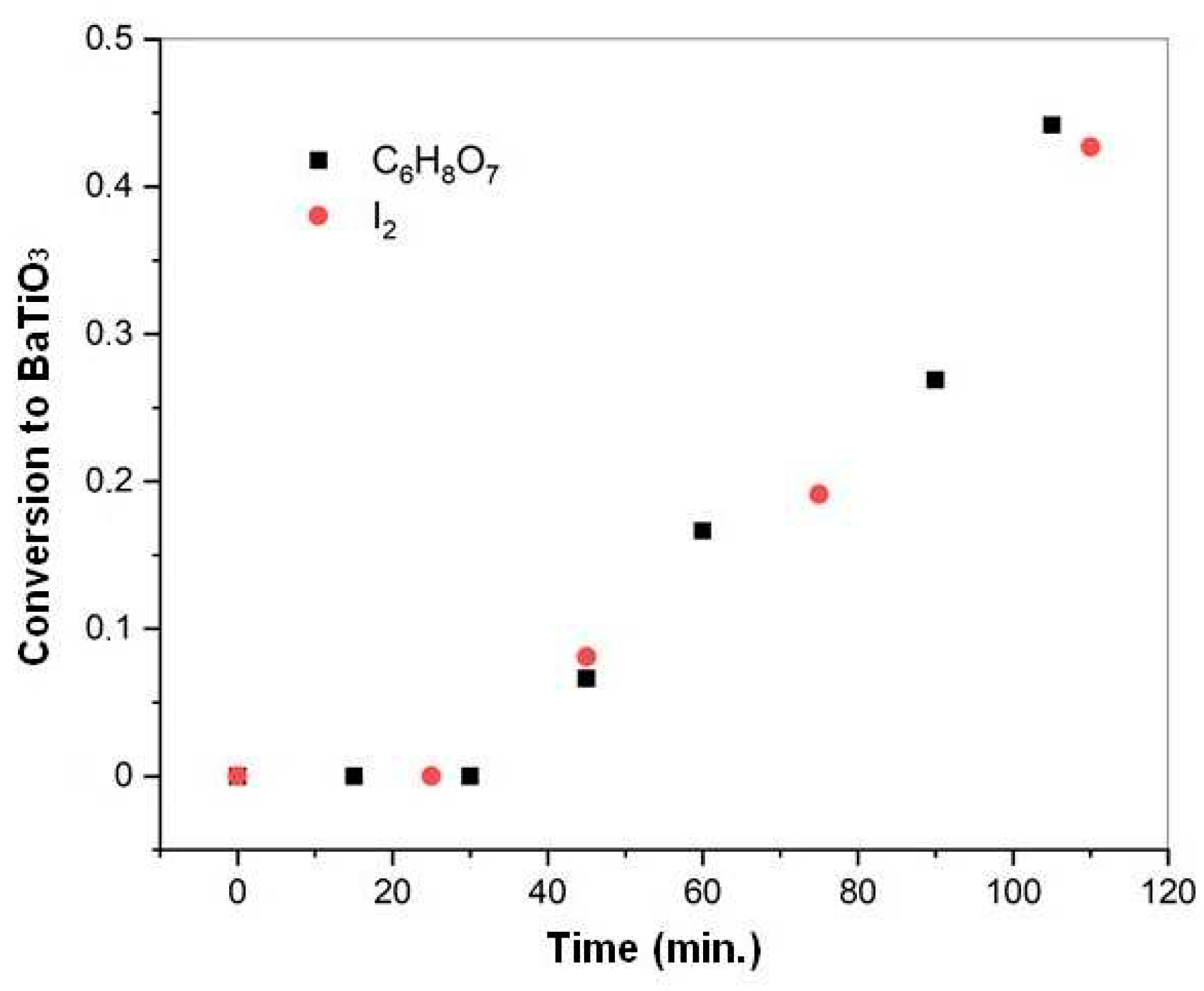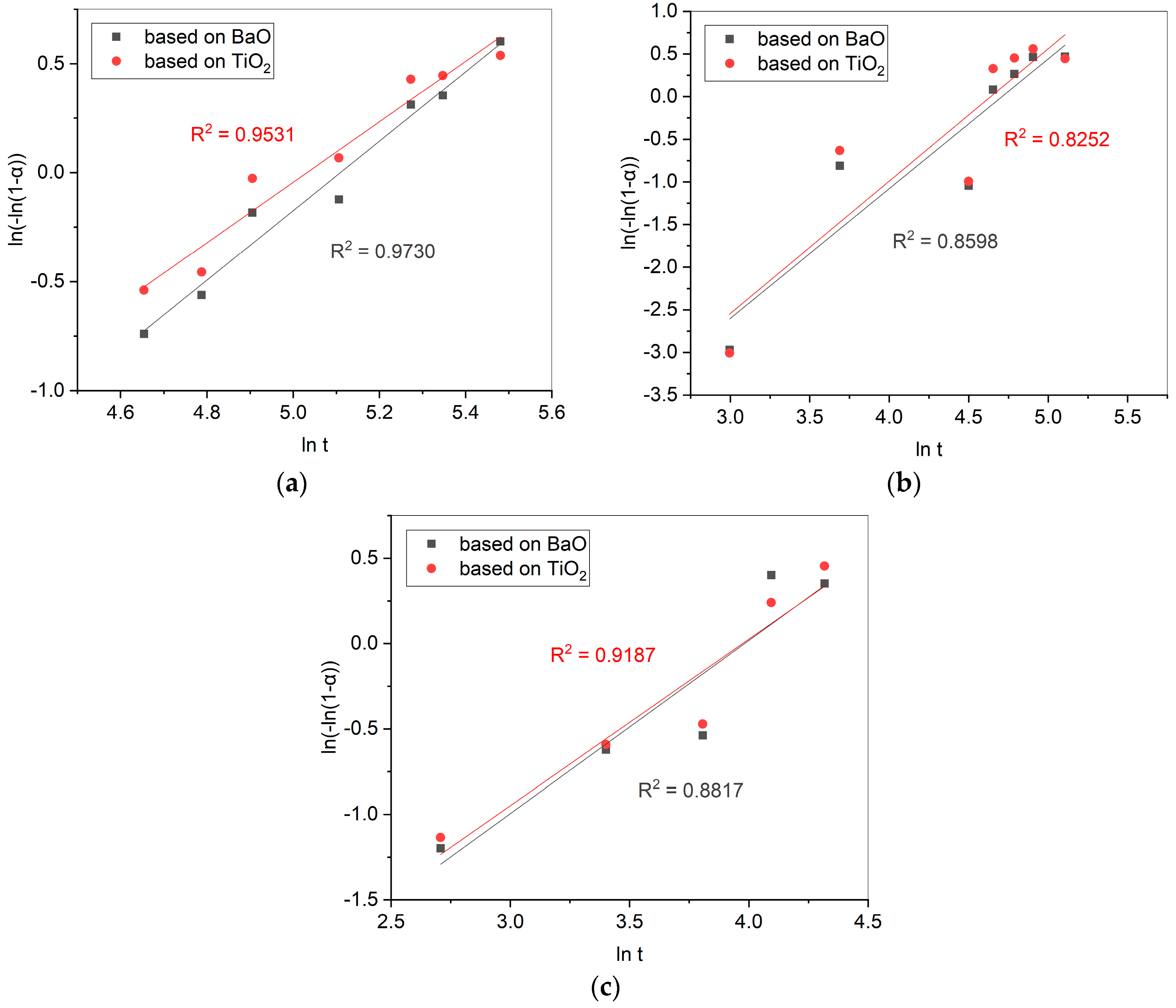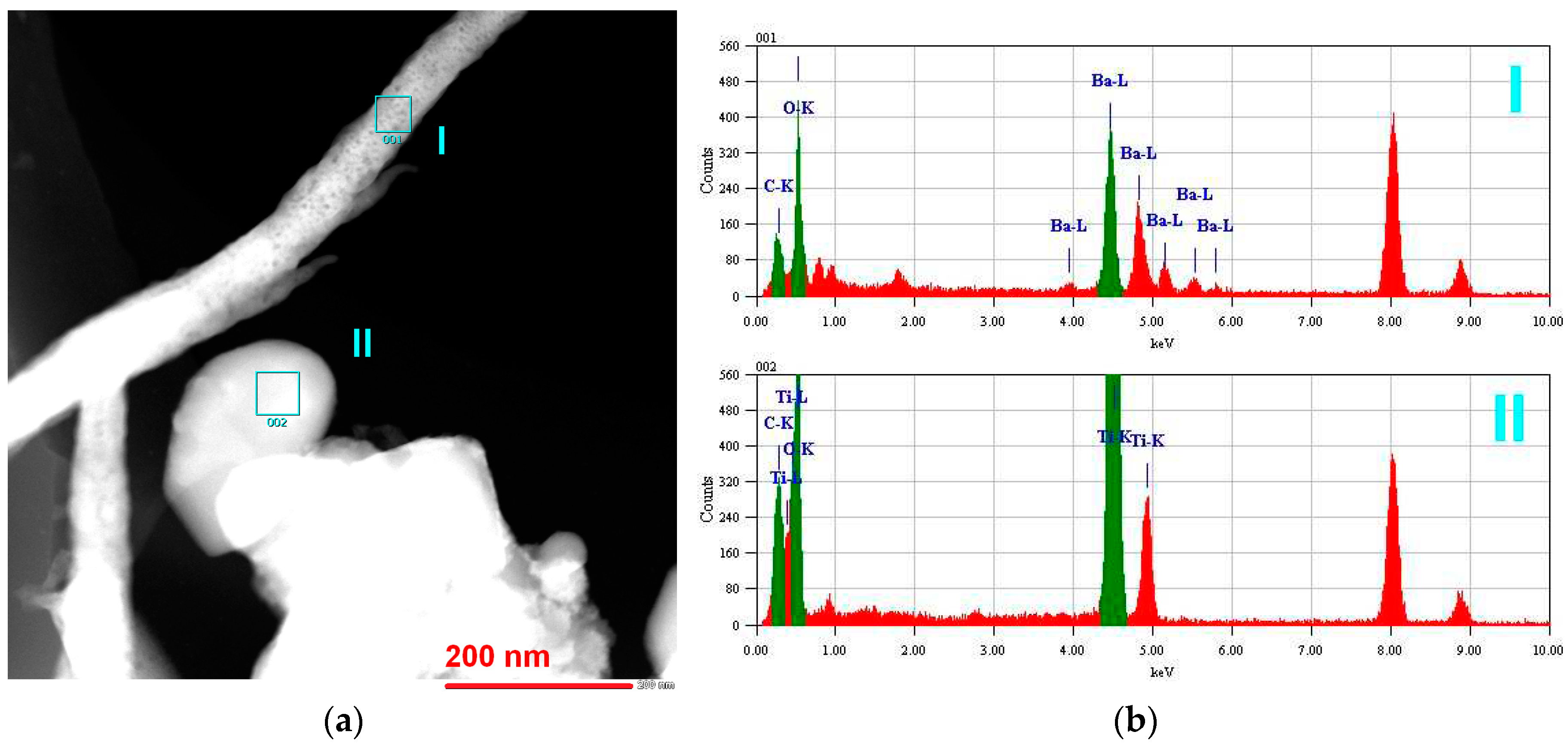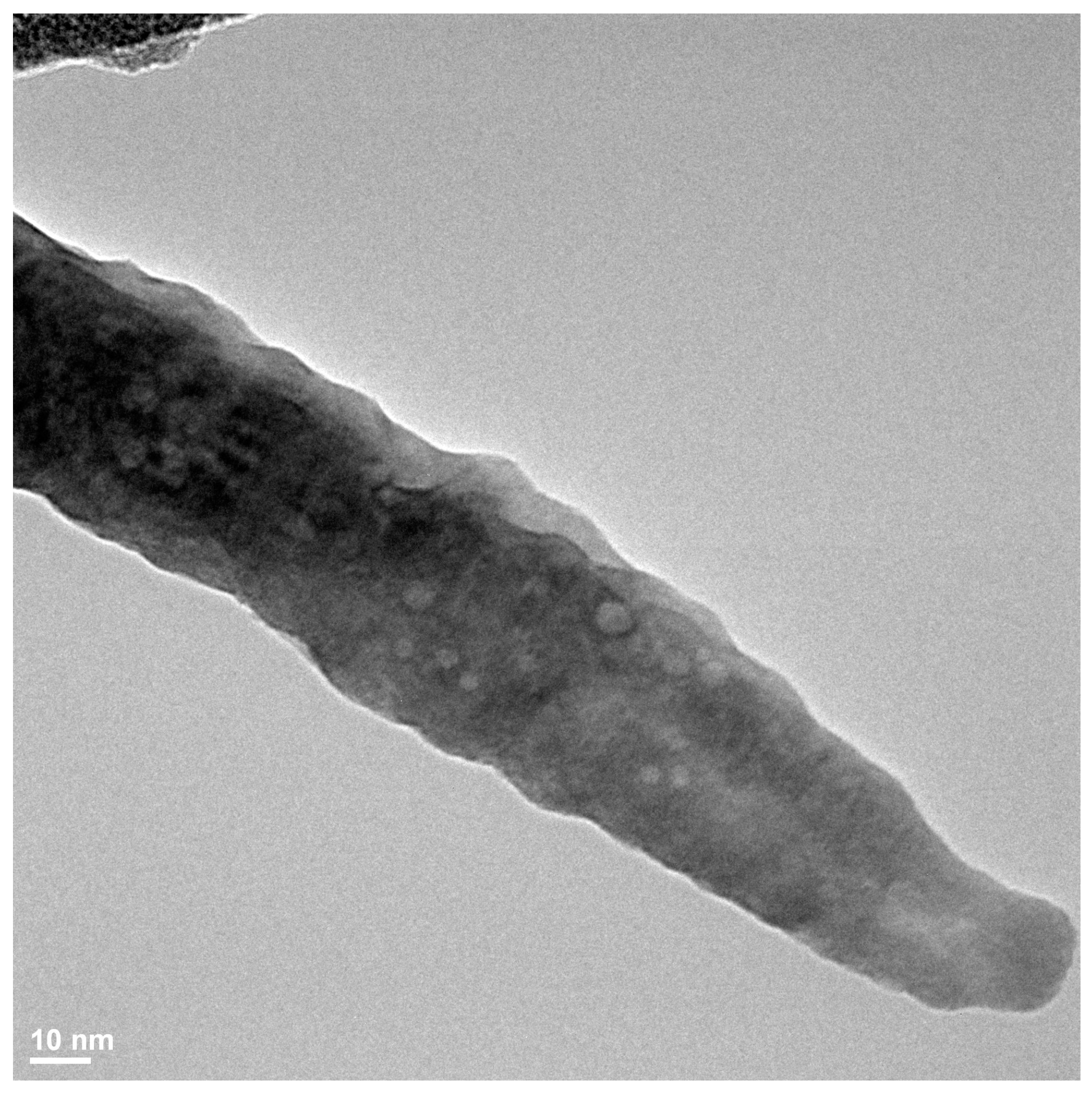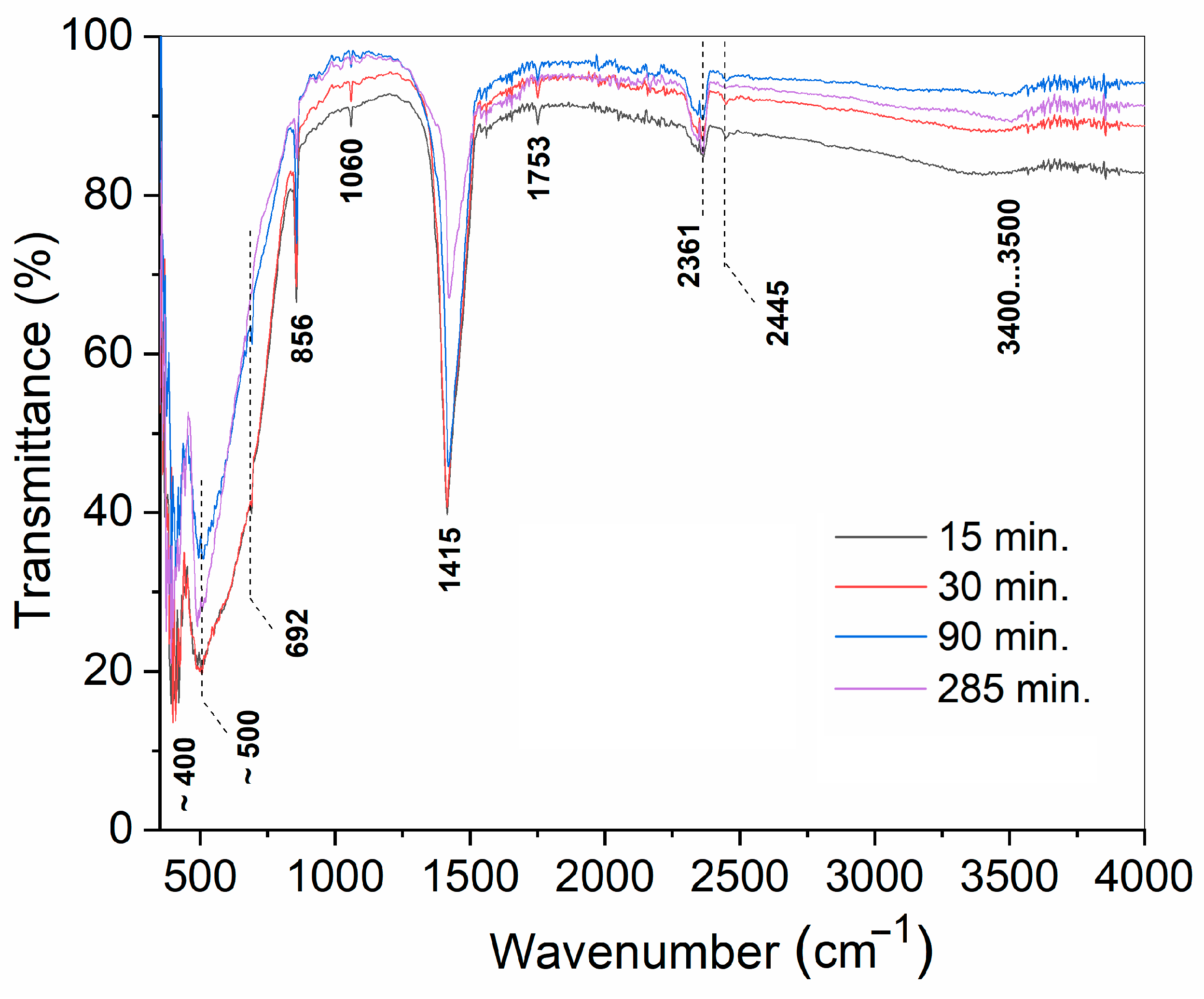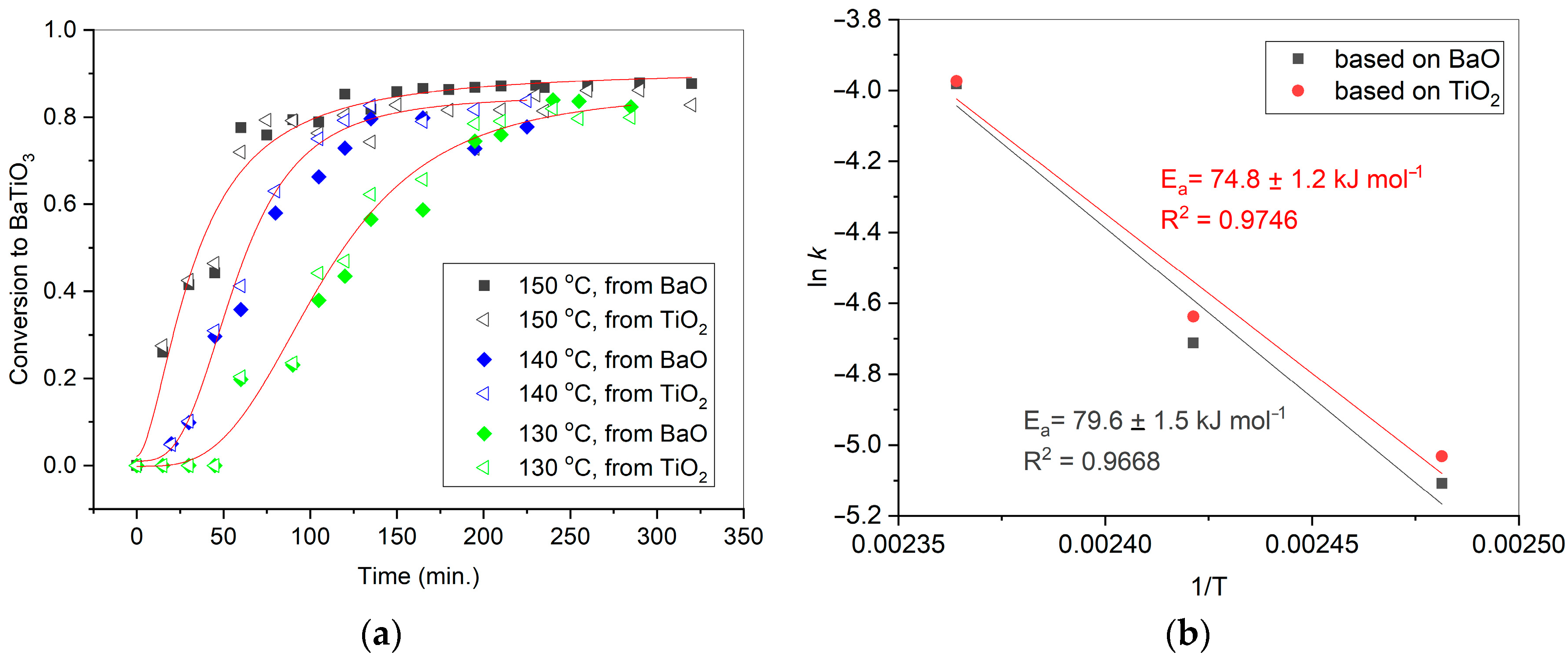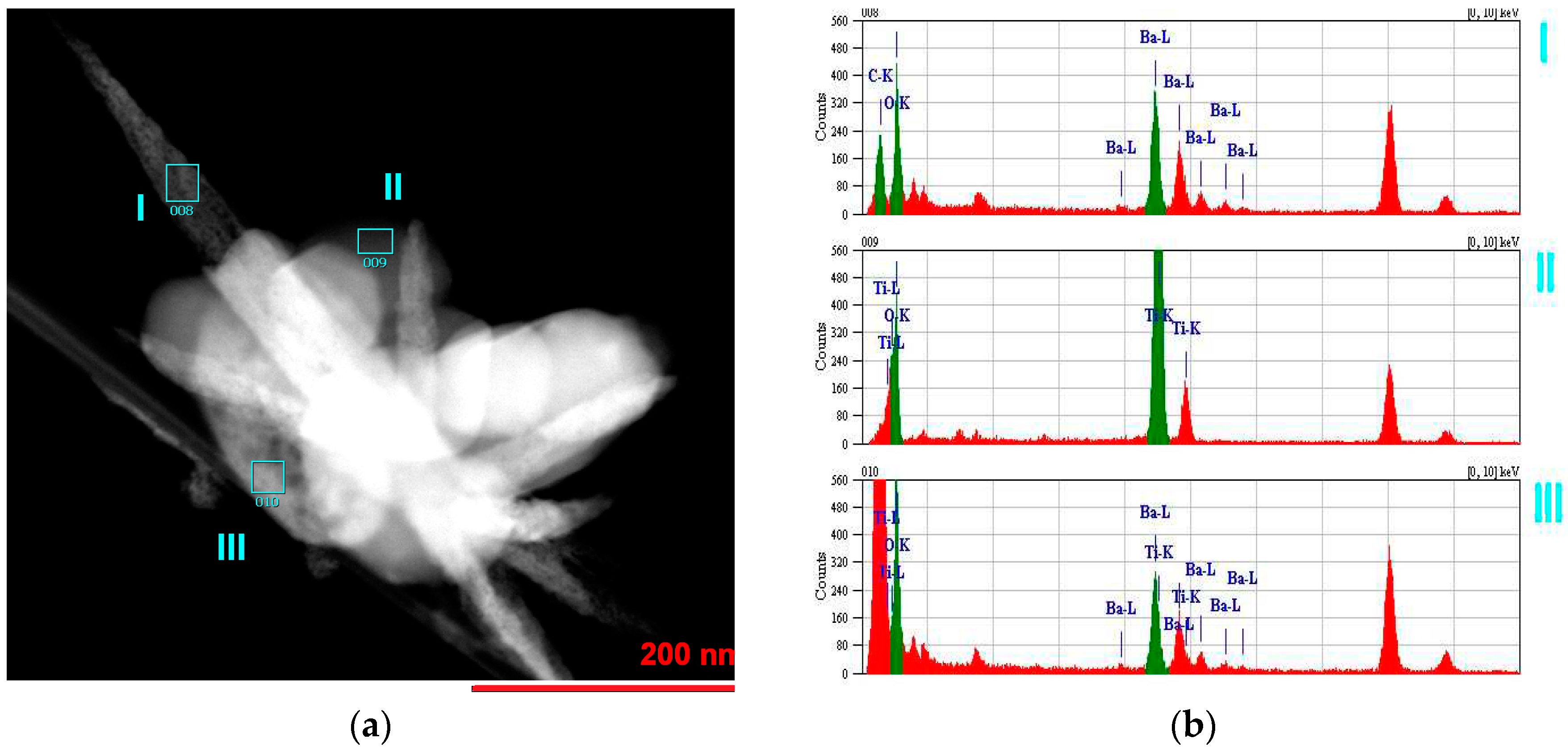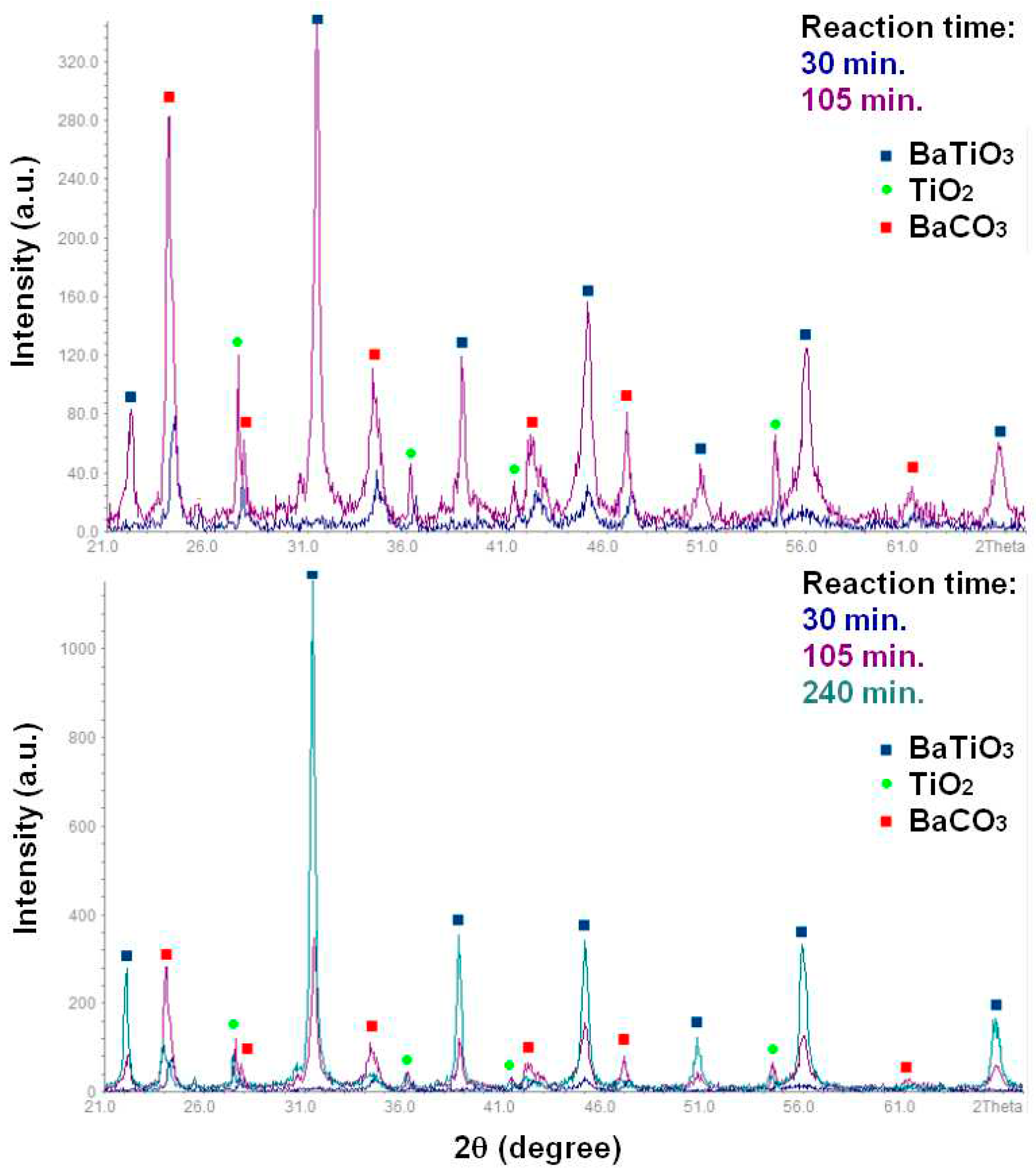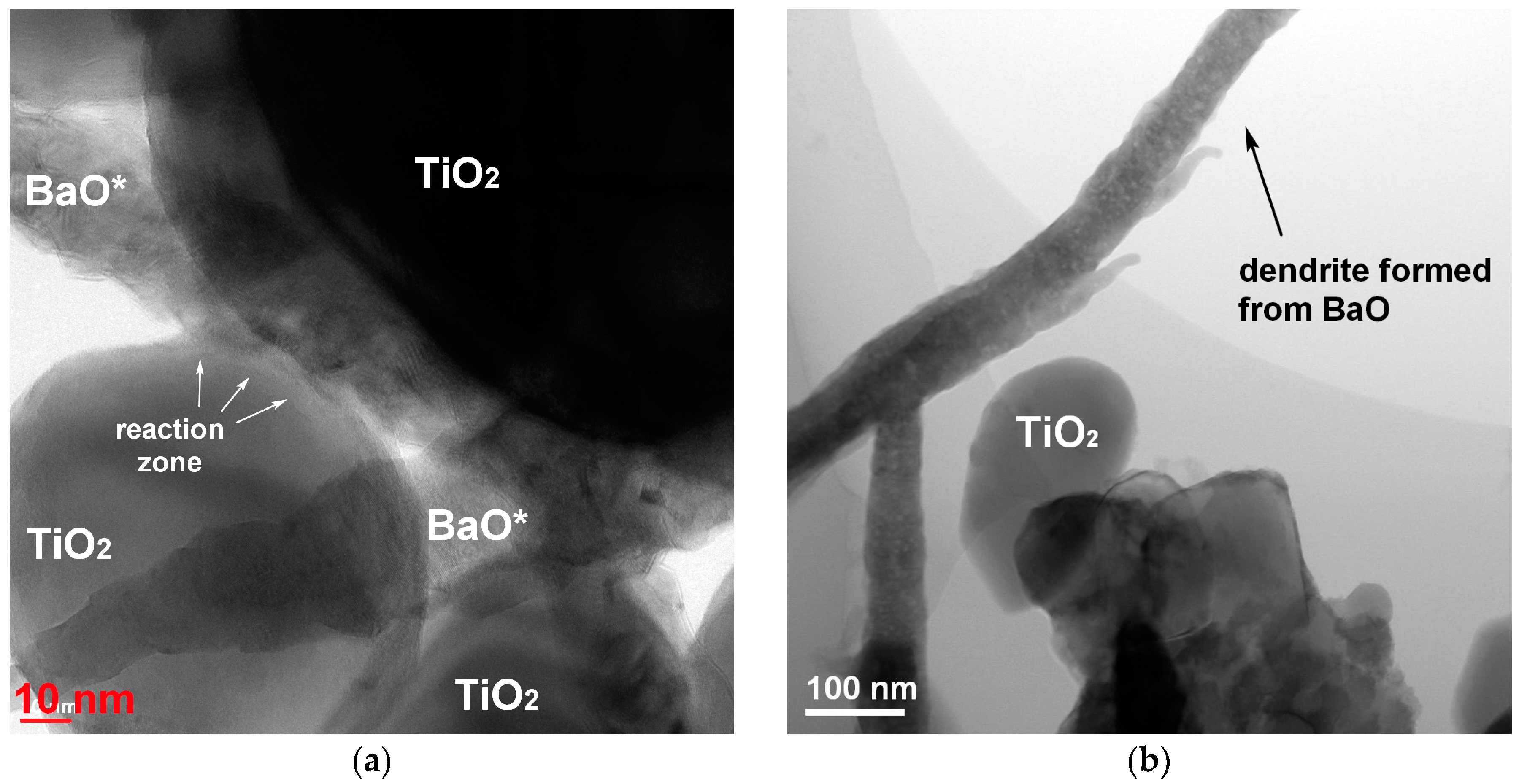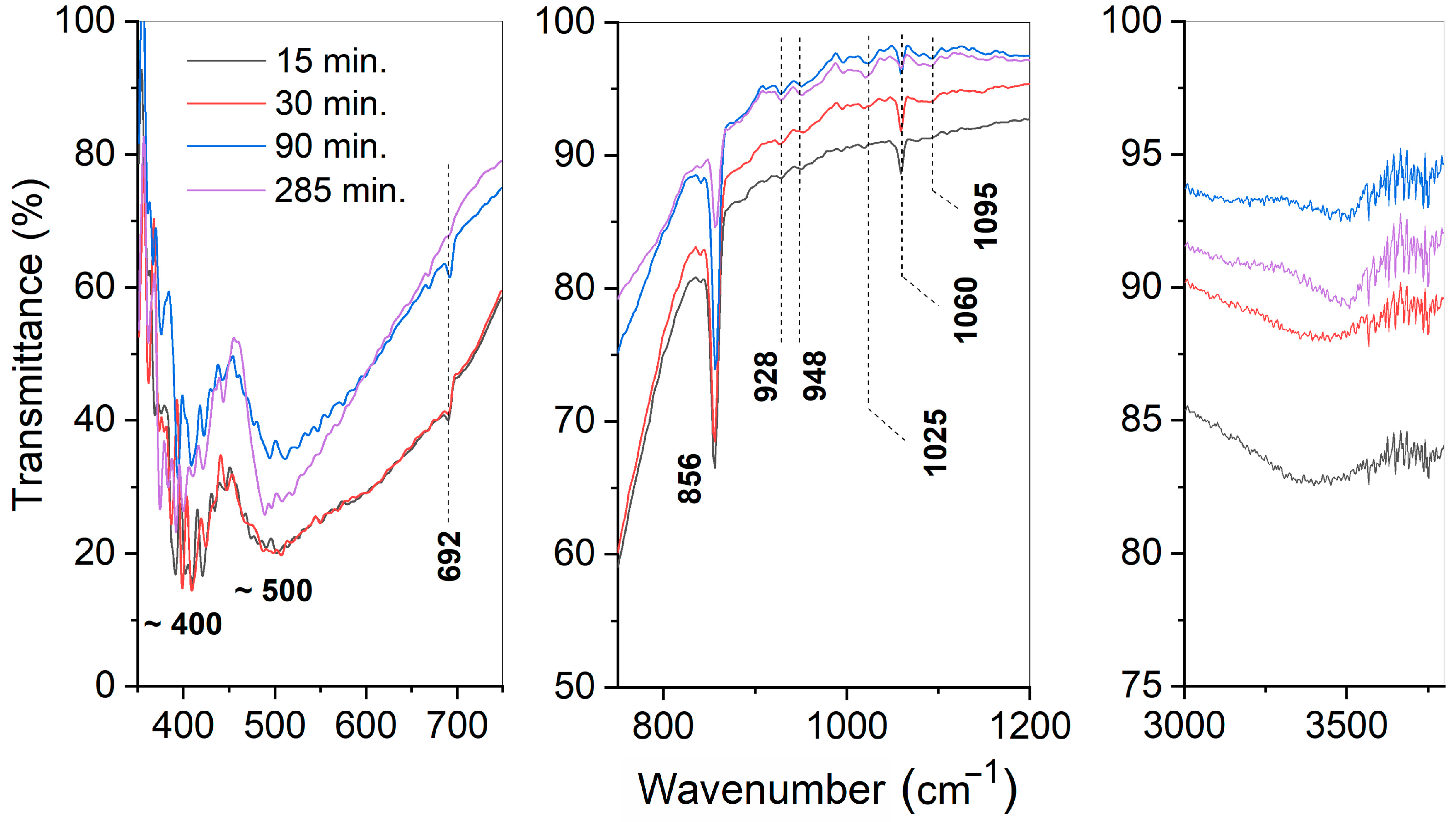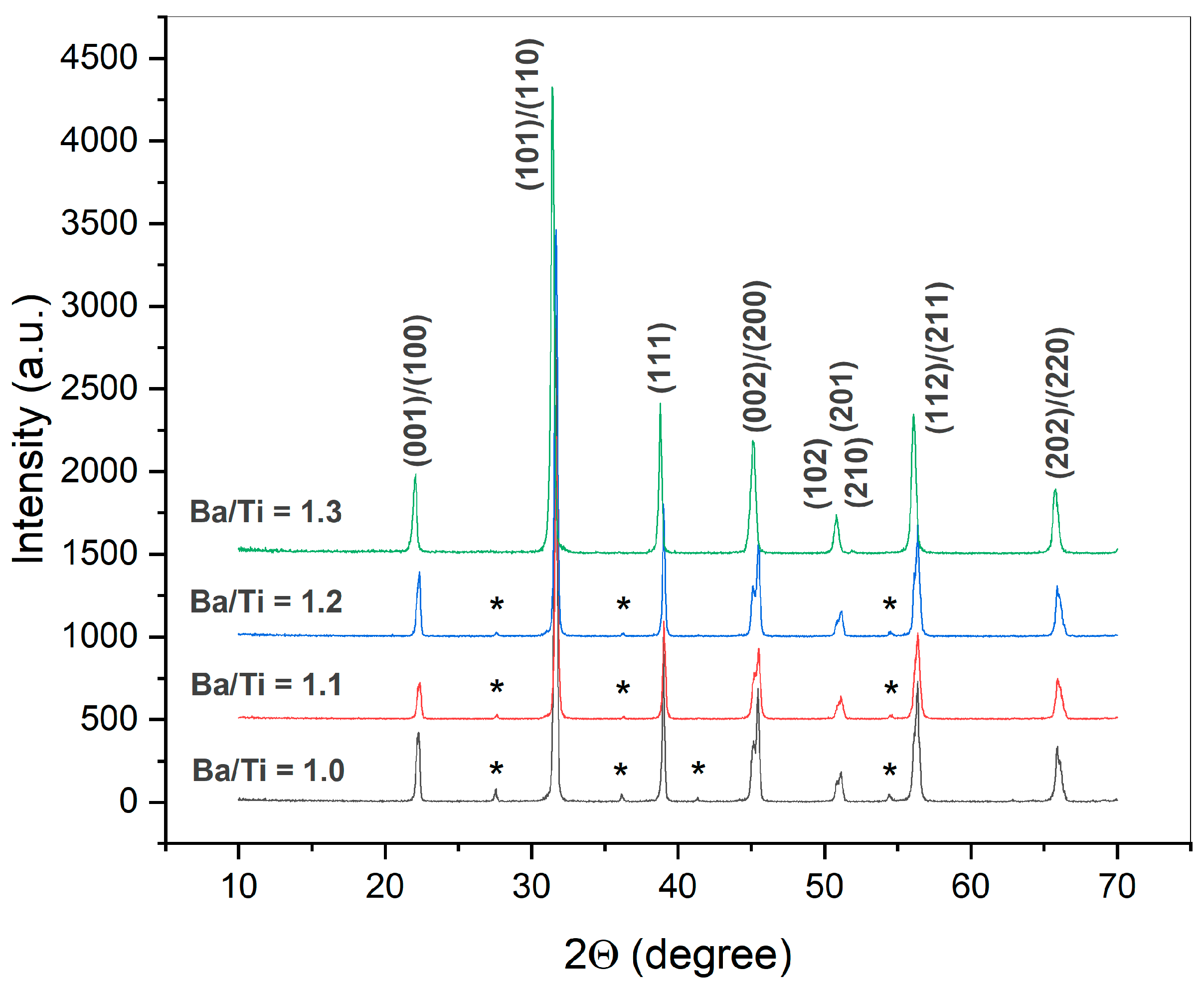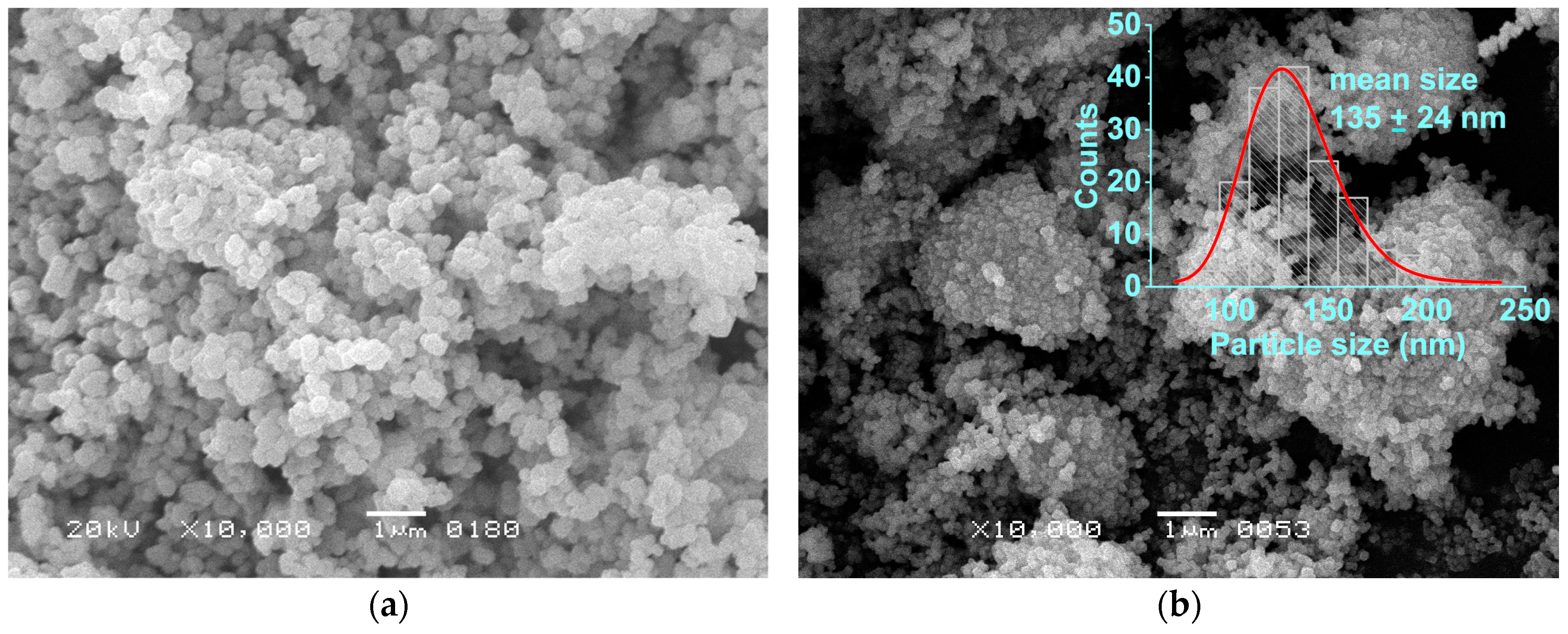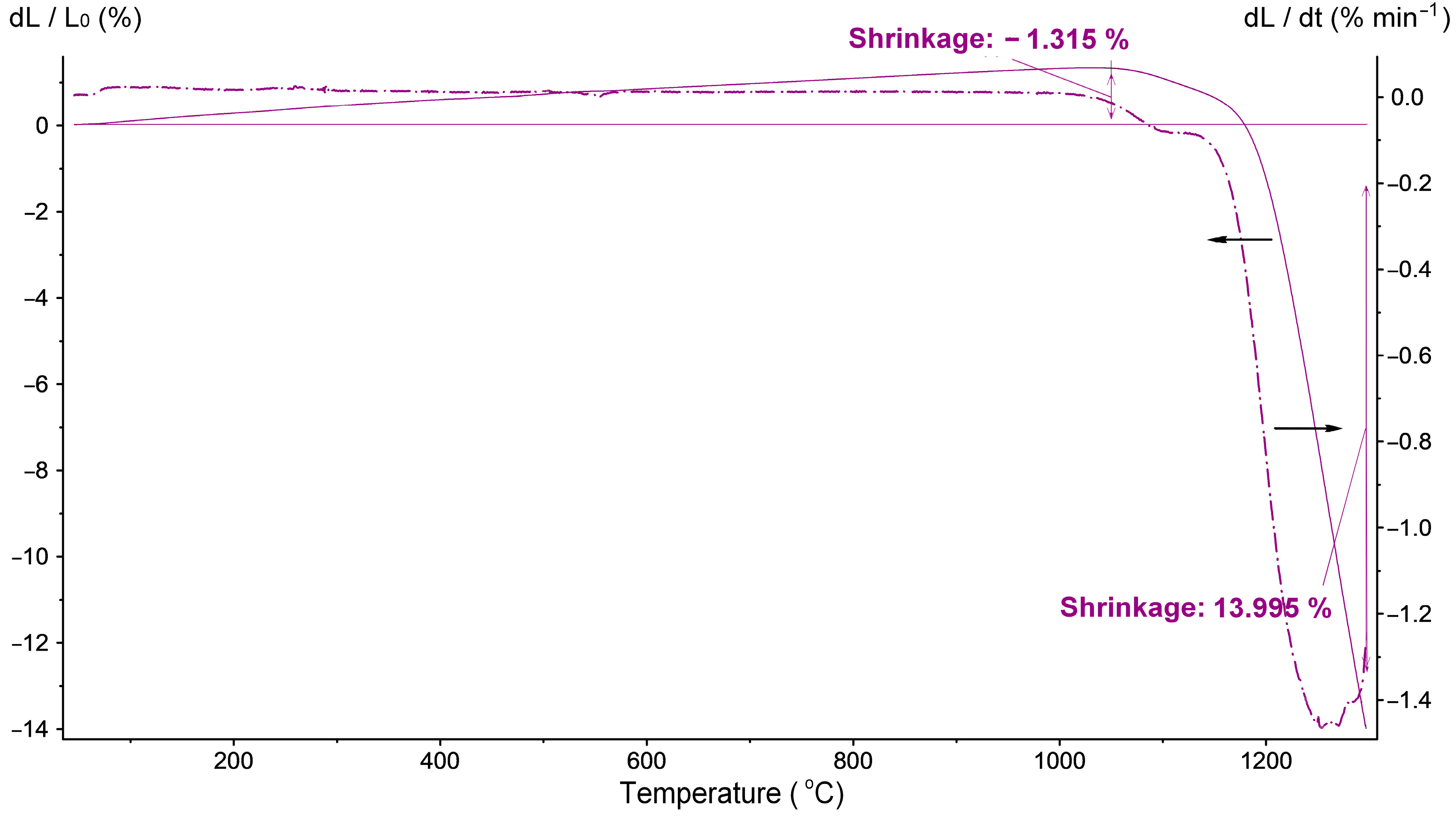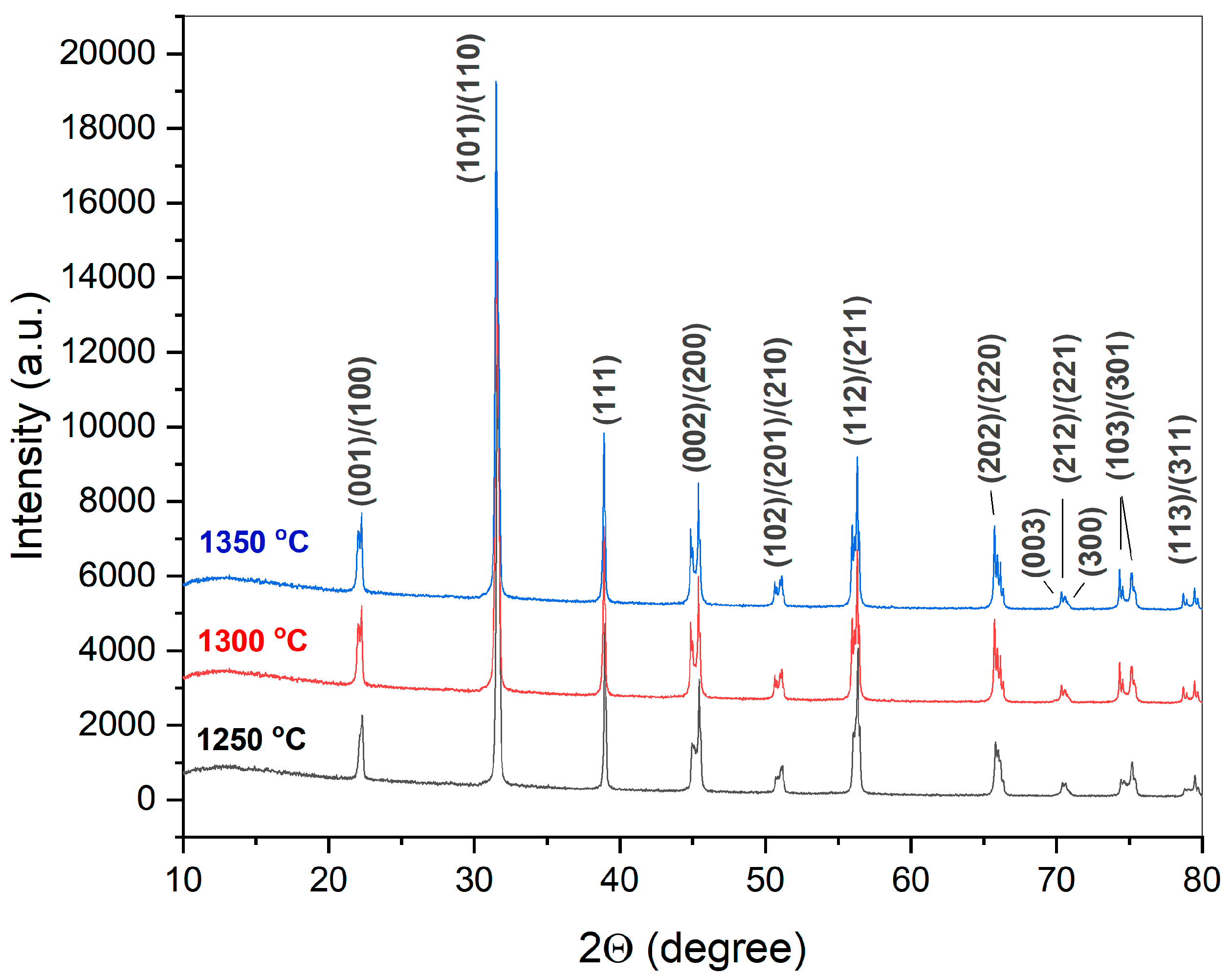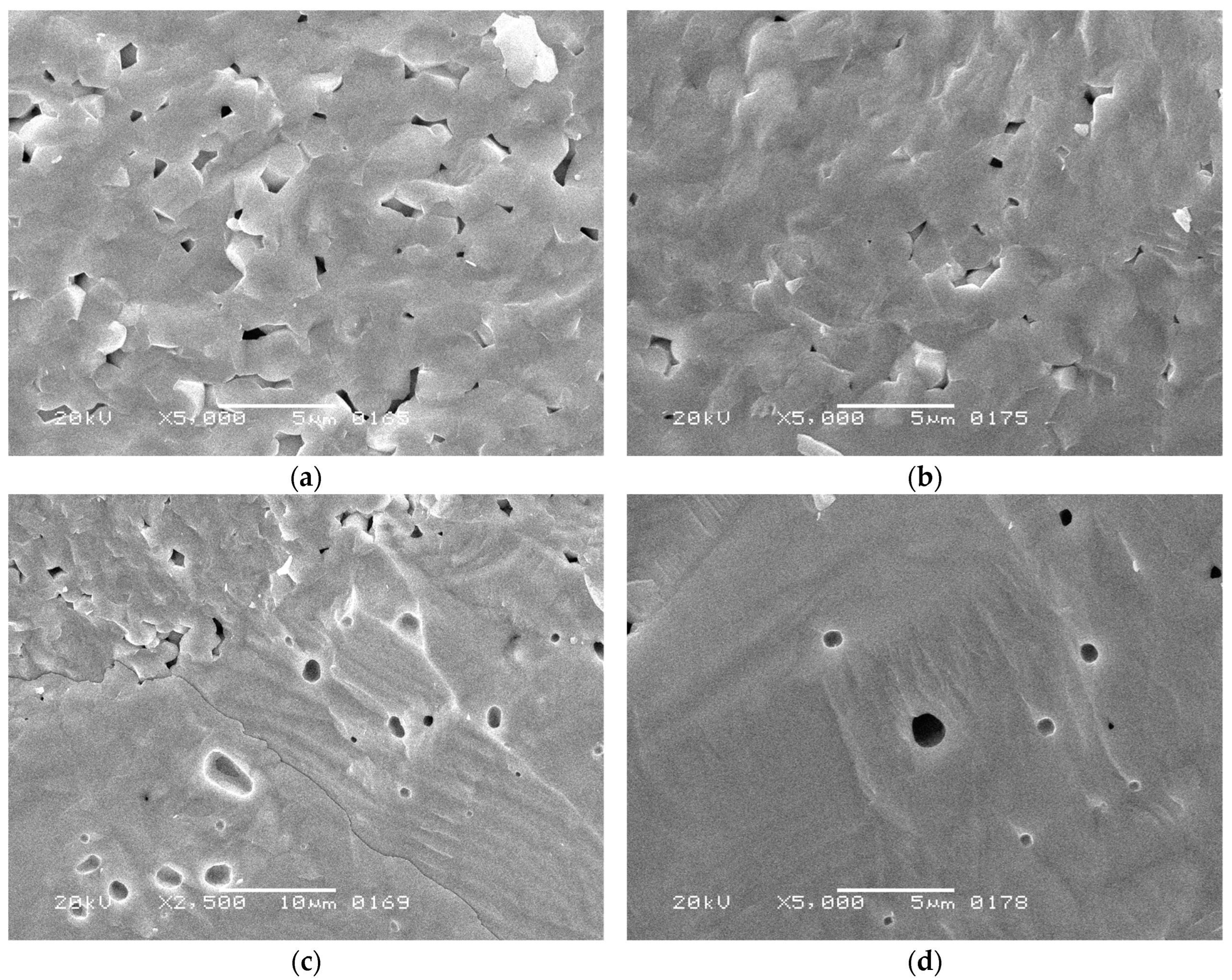1. Introduction
Barium titanate is a highly demanded material for a wide area of applications including production of ferro- and piezoelectric ceramics [
1,
2] and composites [
3,
4] as well as optoelectronic devices [
5], thermistors [
6], semiconductors [
7], transducers [
8], photocatalysts [
9,
10], coatings [
11], and products for biomedicine [
12,
13]. A key feature of such a versatile application of BaTiO
3 is ability of its crystals to perform spontaneous polarization in a temperature range below 120 °C, which is known as its Curie point. BaTiO
3 possesses a typical perovskite structure with a sequence of phase transitions: cubic to tetragonal (120…130 °C), tetragonal to orthorhombic (about 5 °C), orthorhombic to rhombohedral (about -90 °C) [
14]. Besides the cubic modification, the mentioned phases demonstrate ferroelectric properties due to their spontaneous polarization, among which the most prominent are reported for the tetragonal BaTiO
3. A vivid example of this was reported in [
15] for BaTiO
3 ceramics produced by spark plasma sintering with a room-temperature dielectric constant up to 60000 and low losses of about 0.07.
The methods of BaTiO
3 powder production are mostly focused on the needs of multilayer ceramic capacitor (MLCC) industry as it remains the largest consumer of barium titanate. A wide variety of approaches in solid-state as well as wet chemistry have been developed to produce highly pure single-phase BaTiO
3 powders with a narrow size distribution and smooth particle shape [
16,
17,
18]. The groups of solid-state [
19,
20], mechanochemical [
21,
22,
23], complexation [
24,
25,
26,
27,
28], co-precipitation [
29,
30], sol-gel [
31], and hydrothermal [
32,
33,
34] techniques for obtaining BaTiO
3 took their rightful place in laboratories as well as in industry of various scales. Besides the properties of the final product, there are different factors to concern when choosing strategies for BaTiO
3 powders production, such as energy consumption, the availability and cost of the initial substances, the complexity of the equipment and its service, and the environmental impact of the process. In this regard, a method of complex oxides synthesis in a medium of water vapor previously reported for several compositions [
35,
36] including BaTiO
3 [
37,
38,
39,
40] appears attractive as it is operated with widely available simple oxides as starting compounds and requires rather mild conditions for the reaction (temperature below 350 °C and autogenous vapor pressure). Compared to a technically relative hydrothermal method, this one doesn’t imply the use of aggressive media of hardly removable auxiliary substances (NaOH, KOH). On the opposite to the hydrothermal reactions, which realize by the mechanism of the reactants’ dissolution followed by homogenous nucleation and precipitation of the product [
41,
42,
43], the synthesis of BaTiO
3 in water vapor was reported to occur
via a solid-state transformation [
39,
40]. However, there is a lack of available detailed study of the mechanism for this transformation. Besides, the properties of ceramics from a BaTiO
3 powder synthesized in water vapor were poorly investigated as well as a technology for their production wasn’t properly developed [
38,
39]. The current study was aimed to reveal the processes underlying BaTiO
3 formation from the simple oxides in a medium of water vapor and to perform a capability of the synthesized powder as a raw material for dielectric ceramics.
2. Results
2.1. Study of barium titanate formation in a water vapor medium
2.1.1. Composition of the reaction mixture
Conversion of an initial equimolar mixtures of BaO and TiO
2 in the rutile modification was observed during their isothermal dwell at 130 °C in vapor atmosphere with autogenous pressure of 0.27 MPa. The values of conversion calculated from the XRD patterns of the obtained products were shown in
Table A1. After less than 100 minutes dwell, the obtained samples contained no BaTiO
3 phase according to XRD (samples NA-1…NA-6). Further changes in the composition of the initial oxide mixture performed an abrupt and non-monotonic character and had poor reproducibility. Introduction of some additives to the reaction mixture appeared to have a stabilizing effect on its transformation into BaTiO
3.
Figure A1 showed the initial parts of kinetic curves reproducing BaTiO
3 formation from BaO and TiO
2 mixture with the addition of iodine as well as 1.2 wt. % of citric acid. Due to the presence of these additives, the observed part of the kinetic curves achieved a character of monotonic growth following the induction period, which took about 30 min.
Table A2 presented the values of conversion corresponding to the mixtures of starting oxides with different amounts of citric acid, which have been treated in water vapor for equal time. Three-fold difference in the amounts of citric acid didn’t have a significant effect on the degree of the reagents’ conversion. For the further experiments on BaTiO
3 formation kinetics, 1.2 wt. % of citric acid were introduced to the reaction mixture.
2.1.2. Formal kinetic analysis of BaTiO3 formation
Figure 1a demonstrated the degree of conversion in the initial mixture of BaO and TiO
2 versus the duration of its treatment in water vapor medium in the presence of citric acid. For each of the temperatures, there were two curves calculated based on the amounts of BaO and TiO
2 remained after the reaction, respectively. The kinetic curves possessed sigmoidal shape peculiar for the topochemical processes. When processed at 130 as well as at 140 °C, the reaction system passed the induction period, which was associated with the formation and spreading of the reaction zone. The kinetic curve corresponding to 150 °C contained no induction period, because it could occur during the heating. After about 150 min. of treatment at 150 °C, the conversion in the oxide mixture reached a plateau corresponding to 86 % of BaTiO
3 formed. Similarly, at 130 and 140 °C, the conversion of reagents didn’t exceed 83-84 % with a plateau reached after 225 and 210 min. of the processing, respectively.
The analysis of the kinetic curves was provided using the Johnson-Mehl-Avrami-Erofeev equation, often applied for the processes in the solid state [
44]:
where α is the conversion,
k is the rate constant,
t is time, and
m is a parameter. The results of the kinetic curves linearization were presented in
Figure A2, while the calculated ln
k and the parameter
m were shown in
Table 1.
According to Hancock and Sharp [
45], some specific values of the parameter
m could be used to determine the limiting stage of the solid-state reaction. Particularly, when
m = 1.0…1.24, the reaction is limited by the processes occurring at the phase boundary. This could be applied to the considered reaction between BaO and TiO
2 at 150 °C as the parameter was about unity in that case. At lower temperatures, the approach by Hancock and Sharp wasn’t applicable indicating that neither diffusion (
m = 0.54…0.62) nor nucleation (
m = 2.0…3.0) were the only limiting factors.
The Arrhenius plot was used to extract the apparent activation energy from the collected kinetic data (
Figure 1b). Its values calculated based on the fractions of barium and titanium oxides remained in the mixture after each time of treatment were rather close and reached 74.8 and 79.6 kJ mol
-1, respectively.
2.1.3. Microstructural study of BaTiO3 formation
At the temperature of 130 °C, the reaction between BaO and TiO
2 in water vapor occurred the most slowly among the considered conditions, which allowed a detailed observation of BaTiO
3 formation by varying the time of treatment. In the sample obtained in 30 min. of processing and then drastically cooled, two main kinds of particle’s shape were observed by the means of TEM (
Figure 2a). Local EDX analysis (
Figure 2b) revealed that rounded ones belonged to TiO
2 phase (probe II in
Figure 2), while elongated particles contained Ba, C and O atoms among the detectable elements (probe I in
Figure 2). XRD analysis of this sample showed that it consisted of BaCO
3 and TiO
2 in rutile modification (
Figure 3). The presence of BaCO
3 could be explained as a result of the intensive interaction between Ba-containing species formed from BaO in water vapor and CO
2 from air, to which the sample was exposed after the synthesis and then stored before the analysis. Besides, there was a probe III which contained both types of metal ions (Ba, Ti) as well as oxygen and was likely to represent the early stage of BaTiO
3 formation. The composition of the studied sample corresponded to the termination of the induction period of the reaction (
Figure 1a). Longer reaction time at 130 °C resulted in accumulation of the newly formed BaTiO
3 phase, which was observed in XRD patterns (
Figure 3).
Figure 4a showed the particles of TiO
2 contacting with the elongated particles of BaO derivative in the sample treated for 30 min. at 130 °C. Surface diffusion of the reagents led to formation of a neck between their particles. In this area indicated as a reaction zone in the
Figure 4a, BaTiO
3 nucleation was expected to occur and to be followed by the formation of the product layer. Similar processes occurred in agglomerate shown in the bottom of
Figure 4b, where one could see rounded TiO
2 crystals partially covered with a mass of another reagent. Also, in
Figure 4b, it was clearly visible that elongated particles of Ba-containing reagent possessed a dendrite morphology, which pointed to their formation from a melt [
46]. EDX analysis of the particles observed in
Figure 4b was presented in
Figure A3. The origin of the melt was probably connected to the initial BaO hydroxylation and hydration in water vapor followed by its melting. On drastic cooling of the reaction system, this melt solidified in the shape of dendrites. When contacted with air, the hydroxylated barium oxide formed BaCO
3, which was found by XRD and EDX. Another image of the found dendrite structures was shown in
Figure A4.
2.1.4. FTIR study of BaTiO3 formation
Figure 5 performed fragments of FTIR spectra of the powders obtained at 130 °C by the treatment of BaO and TiO
2 equimolar mixture in vapor for 15…285 min. The whole spectra in a range of 4000…350 cm
-1 were shown in
Figure A5. Valence vibration bands of Ti-O and Ba-O bonds [
37,
47] were detected at about 400 and 500 cm
-1 in every studied sample, but in the spectra corresponding to 15 and 30 min. of the treatment, the latter band was asymmetrically broadened towards higher wavenumbers. This band broadening pointed to a weakening of Ti-O-Ti bonds and matched with the induction period in the corresponding kinetic curve (
Figure 1a). Further narrowing of the mentioned band during the treatment reflected saturation of titanium coordination sphere, which naturally accompanied the formation of a new phase of BaTiO
3. There were bands between 1100 and 900 cm
-1 (1095, 1025, 948, and 928 cm
-1), which gradually appeared in the spectra corresponding to 30 to 285 min. of the treatment and might be considered as obertones of the structural vibration in a range of 600…350 cm
-1. On one hand, it pointed to the increase of metal-oxide bonding with the time spent on reactants conversion in BaTiO
3. But also, the multiplicity of these obertones highlighted and imperfect structure of the solid and the presence of similar bonds of different energies, which was attributed to the solid-state transformation.
Wide bands observed in a range of 3500…3400 cm
-1 as well as narrower ones at 1753 and 1060 cm
-1 were related to the presence of the adsorbed water molecules and structural hydroxyl groups [
48]. Noticeably, the band detected at about 3400 cm
-1 and originated from the OH-stretching vibrations in the samples treated for 15 and 30 min. changed its shape in those synthesized during 90 or 285 min. The mentioned band splitted into a broad one, which slightly moved to lower frequencies, and a sharper band at 3500 cm
-1. Such an evolution of FTIR spectrum performed an involvement of water in the reactants’ transformation. Band splitting in the mentioned wavelength region was studied for metal oxides exposed to water vapor and was explained by a different nature of OH groups [
49]. In particular, the sharp band performed the vibrations in hydroxyls connected with metal ions from the lattice, while the broad one corresponded to OH-groups formed by structural oxygen protonation. Resolution of the bands was found to depend on the morphology of the solid as well as on the nature of crystallographic planes the hydroxyls were bonded with. Currently observed transition from a single broad band to a splitted one pointed to the structural changes in the solid phase caused by the failure of the parent TiO
2 structure and the formation of new crystallographic planes of BaTiO
3.
The spectra shown in
Figure 5 and C3 demonstrated the presence of BaCO
3 in the studied samples by its characteristic bands found at 2445, 2361, 1415, 856, and 692 cm
-1.
2.2. Properties of barium titanate ceramics sintered from the powder synthesized in water vapor medium
2.2.1. Characterization of the synthesized powder
In the kinetics and mechanism study of BaTiO
3 formation in water vapor at 130-150 °C described above, any single-phase powder wasn’t obtained. A plateau at the BaTiO
3 formation curve corresponding to 150 °C was observed when the reagents’ conversion approached to 86 %. This could be explained by diffusion limitations of both temperature and morphological nature. On one hand, the temperatures examined above might appear low for volume diffusion initiation, while surface diffusion couldn’t support enough spreading of the reaction zone for the total reagents’ transformation. On another hand, a growing product layer hindered the diffusion of reactants to the front of the reaction. Earlier, it was shown that the reaction in an equimolar BaO and TiO
2 mixture in vapor medium didn’t finalize even after isothermal dwell at 230 °C for 20 h. [
37]. However, when Ba/Ti molar ratio was increased to 1.10…1.14, a single-phase BaTiO
3 was successfully obtained [
39,
40]. In the current research, the reactants were provided by the same suppliers as in [
37] and the conditions of treatment were repeated except to Ba/Ti molar ratio.
Figure 6a performed the results of XRD analysis of the samples synthesized from the initial oxide mixture by the treatment in vapor at 230 °C for 20 h. In accordance with [
37], an equimolar mixture of the reactants led to the formation of BaTiO
3 with an admixture of TiO
2.
Table 2 presented the calculated amounts of TiO
2 remained in the prepared powders. One could see that the increase of Ba/Ti ratio to 1.3 gradually carried to a full consumption of the initial TiO
2 and to the formation of a single-phase BaTiO
3 powder.
XRD patterns of the synthesized powders corresponded to BaTiO
3 in a tetragonal modification. A characteristic splitting of (002)/(200) peaks in the patterns were shown in
Figure 6b. It was noticeable that the growth of barium excess in the reaction system resulted in a disappearance of this splitting. As it was calculated from the XRD data, the approaching of the reaction system to full transformation of TiO
2 into product was accompanied by a decrease in BaTiO
3 tetragonality (c/a cell parameter ratio) (
Table 2). This could be connected to the formation of a core-shell structure of BaTiO
3 particles [
50,
51]. This phenomenon had been described for nanosized particles and grains of BaTiO
3. Previously [
37], the particles obtained similarly to the current route were shown to consist of agglomerated crystals, which were 100-nm sized in average. Tetragonal phase known to be stable below the Curie point of BaTiO
3 (~ 130 °C) was reported to become deteriorated by a high concentration of structural defects near to the surface of the particle [
52]. For this reason, it partially transforms into pseudocubic modification, which leads to a composite structure of the particle: a pseudocubic shell and a tetragonal core. Pseudocubic phase possesses the same XRD profile as a high-temperature cubic modification of BaTiO
3. Coexistence of the mentioned BaTiO
3 modifications and the changes in their fractions between the synthesized powders with different Ba/Ti ratio resulted in different tetragonality, which was calculated as an average value for each sample’s volume.
The morphologies of the initial TiO
2 powder and the resulting single-phase BaTiO
3 were shown in
Figure 7. From the analysis of SEM images, BaTiO
3 powder consisted of micron-sized agglomerates of round-shaped particles from a range of 90 to 220 nm with a mean value of 135 nm (
Figure 7b). The observed agglomerates were likely to form directly from the particles of TiO
2 (
Figure 7a). Similar inheritance of the starting TiO
2 morphologies by BaTiO
3 during the synthesis in water vapor was described elsewhere [
40]. Noticeably, the agglomerates visually differed in their density and neighbored to almost dispersed particles (
Figure 7b). This pointed to a gradual deagglomeration of BaTiO
3 during the treatment in vapor, which should be accompanied naturally by an increase of the powder’s surface area. Such an increase in surface could be considered as a factor governing the decrease of powder’s tetragonality with approaching to the reaction termination (
Table 2).
The single-phase BaTiO
3 powder synthesized from BaO and TiO
2 mixture with Ba/Ti = 1.3 was selected as a raw material for ceramics manufacturing via conventional route including room-temperature pressing followed by a high-temperature sintering. To estimate its sintering behavior, a dilatometric analysis was provided (
Figure 8). From 40 to 1025 °C, only thermal expansion with a constant rate was detected. In an interval of 1025-1080 °C, a fist stage of shrinkage associated with particles’ re-orientation occurred and was followed by an interval of sintering accompanied by pore elimination. The highest rate of shrinkage was fount between 1252 and 1270 °C. Above 1295 °C, real sintering was expected to finalize and change to the grain growth.
2.2.2. Properties of the sintered ceramics
Starting from the results of the dilatometric investigation of the synthesized BaTiO
3 powder, its sintering was carried out in a temperature range of 1250…1350 °C. According to XRD analysis of the prepared ceramics, single-phase tetragonal BaTiO
3 was obtained at each of the sintering temperatures (
Figure 9). Material consolidation and elimination of the structural defects during the ceramics processing relieved spontaneous polarization, which led to the tetragonality enhancement compared to the raw powder (c/a = 1.0057) (
Table 3). Besides, the tetragonality slightly increased with the sintering temperature.
SEM study of the prepared ceramics revealed a formation of rather dense microstructures (
Figure 10). When sintered at 1250 °C, the material consisted of micron-sized grains (mean size 2.09 ± 0.44 μm) partially separated by open pore space (
Figure 10a). Its relative density appeared 94 % (
Table 3), which could be considered as high for the conventional ceramics technology. The material sintered at 1300 °C performed slightly higher density, but its microstructure was less homogenous demonstrating micron-grained areas (
Figure 10b) neighboring to the regions with round-shaped pores (
Figure 10c). The latter probably originated from discontinuous grain growth [
53] in a fine-grained matrix. The presence of these large grains lowered the concentration of paraelectric grain boundaries [
54,
55] thus contributing to the increase in tetragonality. At 1350 °C, the sintering process occurred with an involvement of a liquid phase, which was reflected in the formation of large grains with spherical pores inside only (
Figure 10c). Liqiud phase formation was caused by possible peritectoid and eutectoid processes, which were reported for nearly stoichiometric barium titanate compositions at 1250…1320 °C [
56,
57]. The relative density of the corresponding sample reached 96 %, and its tetragonality increased as well. However, the grain boundaries nearly disappeared, which together with the darkening of the sample proved the vicinity of the overburnt state.
Despite the enhancement in the relative density and tetragonality of BaTiO
3 ceramics caused by the increase of the sintering temperature, their dielectric properties demonstrated high sensitivity to the microstructure (
Table 3). The highest dielectric constant was determined for the fine-grained material sintered at 1250 °C. Structural inhomogeneities in the sample sintered at 1300 °C led to a comparative decrease in the permittivity, while approaching to a burnout at 1350 °C caused a drastic decrease of this characteristic. The loss tangent performed a sensitivity to the type of pore space. It was higher in the sample with open intergranular porosity (ceramics sintered a 1250 °C) then in those with combined inter- and intragranular pores (sintered a 1300 °C) or just closed porosity (sintered a 1350 °C). Open pores were prone to adsorb water molecules from the atmosphere, which caused extra conductivity.
3. Discussion
Once subjected to water vapor, the particles of BaO and TiO
2 from the initial reaction mixture adsorbed water molecules and underwent surface hydroxylation. BaO is known to add water with the formation of a layer of amorphous hydroxide and further hydration into Ba(OH)
2·
xH
2O [
58,
59,
60]. For TiO
2, both molecular and dissociative adsorption of water are typical [
61]. Apparently, this resulted in formation of similar charges on the particle’s surfaces, which led to their mutual repulsion. An introduction of foreign electrolyte locally changed the electrostatic conditions in the mixture and supported the formation of contacts between the reactants’ particles. For this reason, the presence of small amounts of citric acid in the reaction mixture stabilized the initial stage of BaO and TiO
2 interaction. An additive of iodine reacted with water molecules to generate HI and HIO, which acted in a similar way as citric acid making for a stable growth of reagents’ conversion with the time.
The observed reaction between the initial oxides possessed the features of a topochemical process [
62]. The conversion
vs. time curves for BaO-TiO
2 system in water vapor demonstrated sigmoidal shape with an induction period imprinted at 130 and 140 °C. At this stage, the reactants’ hydration and hydroxylation occurred accompanied by melting of the hydrated Ba(OH)
2 as it was revealed by TEM. These processes allowed formation and growth of a contact area between the reactants’ particles. Due to the interaction with water molecules, the surfaces of the reactants became highly defective, which facilitated the appearance of a reaction zone. BaTiO
3 nucleation and its growth initiated autolocalization of the process and moved the front of the reaction inward the TiO
2 particles. These autolocalization was accompanied and promoted by hydroxylation of the oxide structure as it was shown by FTIR study. The corresponding part of the kinetic curves performed an increase in BaTiO
3 fraction. From the analysis of kinetics, this complex process was likely to be controlled by the phase transformations rather than by diffusion. However, the collected data didn’t allow any unambiguous conclusion whether the process was limited by the product nucleation or by the phase-boundary phenomena. Nevertheless, the final part of the kinetic curves, i.e. reaching a plateau, should be caused by the diffusion limitations, which were overcame by enough excess of barium ions in the reaction medium.
The calculated apparent activation energy of the studied reaction (75-80 kJ mol
-1) was close to those reported for BaTiO
3 formation from TiO
2 in a concentrated Ba(OH)
2 solution (105 kJ mol
-1) recognized as a topochemical process as well [
63]. A conventional high-temperature solid-state synthesis of BaTiO
3 was characterized by a higher activation energy of 361 kJ mol
-1, while for a reaction between the same reactants (BaCO
3 and TiO
2) in water vapor at 700 °C it was determined as 142 kJ mol
-1 [
64]. These results emphasized a key role of water in facilitating the studied topochemical reaction due to defects generation on the surface of the reactants and further in their bulk. Current study proved the propositions and conclusions on the mechanism of BaTiO
3 formation from a mixture of simple oxides in water vapor outlined in the earlier works [
37,
39,
40].
BaTiO
3 powder currently produced in water vapor performed rather high capability in the manufacturing of ceramics for low-frequency applications.
Table 4 collected some of the recent data on the structural and dielectric characteristics of pure BaTiO
3 ceramics obtained by the conventional technique. Most of these materials were produced from nanosized or nearly nanosized powders by pressing at different loadings (50…400 Pa) with subsequent sintering at a temperature from a range of 1050…1350 °C for several hours. It is known that achievement of a full density is quite difficult for the conventional route, so the reported materials possessed relative densities of 92…97 % of the theoretical value (6.02 g cm
-3). However, the density is not the deciding factor for the functional properties of BaTiO
3 ceramics. In case of a sufficient densification, the grain size is known to affect the dielectric properties of BaTiO
3. Among them, the highest dielectric constant was observed when the grain size of BaTiO
3 was about 1 μm. This effect could be followed from the data in the
Table 4 as well. The ceramics obtained in the current work performed worthy values of the dielectric constant compared to the other mentioned results. Besides, its loss tangent was maintained at the level of 0.02 up to 1 MHz, which was acceptable for this class of materials [
65]. Nevertheless, the use of novel approaches different from the conventional ceramics manufacturing, for instance, two-step sintering [
66,
67,
68], cold sintering process [
69,
70,
71,
72] etc., would open a perspective for microstructural engineering and effective application of BaTiO
3 powders synthesized in water vapor medium.
4. Materials and Methods
Barium oxide (BaO, purity > 99.9 %, GOST 10203-78, supplied by LLC Laverna-Lab, Moscow, Russia), titanium dioxide in a rutile modification (TiO2, purity > 99.9 %, STP TU COMP 2-340-11 supplied by LLC Komponent-Reactiv, Moscow, Russia), citric acid monohydrate (C6H8O7·H2O, purity > 99.9 %, GOST 3652-69, supplied by JSC LenReactiv, St.-Petersburg, Russia) and crystalline iodine (I2, purity > 98 %, GOST 4159-79, supplied by JSC LenReactiv, St.-Petersburg, Russia) were used as initial substances for the synthesis of BaTiO3.
To prepare a reaction mixture, the calculated amounts of BaO and TiO2 with Ba/Ti molar ratio of 1.0, 1.1, 1.2, or 1.3 were jointly mixed using an agate mortar and pestle and placed into PTFE containers. If it was provided, a corresponding amount of citric acid monohydrate (0.6; 1.2 or 2.4 wt. % with respect to the mixture) was added to the reactants and underwent the joint mixing. To introduce iodine additive to the reactants, it was preliminarily applied in the surface of TiO2 as follows. An open crucible with 4 g of TiO2 was placed into a glass buks containing 1 g of I2. The buks was closed and stored at room temperature for 4 days. After that TiO2 was removed and used for the preparation of a reaction mixture as it was described above. The PTFE container with the reaction mixture was placed into a laboratory stainless-steel autoclave of 12…17 cm3 volume, which contained 2 ml of distilled water at the bottom. The autoclave was sealed and placed into a furnace to be heated up to 130…230 °C with a rate of 80 °C h-1. The corresponding vapor pressure generated inside the autoclave was 0.27…2.94 MPa. The autoclave was stored in these conditions for 0 to 20 h, after which it was removed from the furnace and drastically cooled by dipping of its bottom in cold water (about 14 °C). This method of cooling allowed water to condense on the bottom inside the autoclave separately from the container with the product. After that, the autoclave was opened, the product was removed from it and dried in air at a temperature of 70…80 °C for 12 h. If it was provided, the product was washed in 5 wt. % acetic acid solution and distilled water to remove the excess of barium ions.
Ceramics processing was carried out with the use of 5 wt. % of polyvinyl alcohol aqueous solution as a temporary binder. Green pellets were prepared by uniaxial pressing at 150 MPa and then sintered at 1250, 1300 or 1350 °C for 1 h in air. Density of the obtained ceramic samples was determined by Archimedes method using kerosene. The processing procedure as well as metallization were described in detail elsewhere [
80].
XRD analysis of the synthesized powders and crashed ceramic samples was provided with the use of the following diffractometers: STOE STADI P with CuKα radiation (STOE & Cie GmbH, Darmstadt, Germany), Rigaku D/Max-2500 with CuKα radiation (Rigaku Corp. Tokyo, Japan), and PowDiX 600 with CuKα+β radiation (CJSC Linev Adani, Minsk, Belarus). The patterns were recorded in a range of 10° < 2θ < 80° with a step of 0.02°. ICDD PDF2 database was used for the phase analysis [
81]. Whole diffraction pattern profile fitting was carried out using Le Bail method by means of GSAS [
82] and FullProf [
83] software. The structural models of BaTiO
3 (tetragonal), TiO
2 (rutile) and BaCO
3 (witherite) were found in Crystallography Open Database [
84]. Quantitative analysis of the samples as well as cell parameters refinement was provided by Rietveld method [
85].
Scanning electron microscopy of the powders and the ceramics fracture surfaces was performed at Jeol JSM 6380 (Jeol Ltd., Tokyo, Japan). Transmission electron microscopy combined with EDX study was conducted using Jeol JEM-2100 F (Jeol Ltd., Tokyo, Japan).
FTIR study of the synthesized powders was provided at WQF-530A spectrometer (Beijing Beifen-Ruili Analytical Instrument (Group) Co. LTD, Beijing, China) in a wavenumber range of 4000…350 cm-1 by attenuated total reflectance method.
Dielectric constant and loss tangent of the sintered ceramic disks with metallized plane parallel sides were calculated from the capacitance measurements carried out at GW Instek LCR-78210 meter (Good Will Instrument Co., Ltd., Xinbei, Taiwan).
5. Conclusions
Currently, we have studied in detail the process of BaTiO3 formation from a mixture of solid oxides of barium and titanium in a medium of water vapor being in equilibrium with the liquid at 130…230 °C and 0.27…2.94 MPa. This process was revealed to occur as a topochemical reaction, which could be divided in an induction period and the following periods of a rapid conversion and its deceleration. The initial reactants underwent first surface hydration and further hydroxylation, which facilitated the autolocalization of the process. Barium oxide was found to transform into a melt when exposed to the conditions of the synthesis in water vapor. The apparent activation energy of BaTiO3 formation in water vapor was estimated as 75…79 kJ mol-1. To obtain a single-phase BaTiO3 in these conditions, an excess of barium ions was required corresponding to Ba/Ti molar ratio equal to 1.3 in the initial mixture. At 230 °C and a vapor pressure of 2.94 MPa, a tetragonal BaTiO3 powder with a mean particle size of 135 ± 44 nm was obtained. Based on this powder, a conventional ceramics technique allowed preparation of single-phase tetragonal BaTiO3 ceramics with a grain size of about 2 μm and a room-temperature dielectric constant of 3820…3791 depending on the frequency and a loss tangent less than 0.02. Synthesis of BaTiO3 in water vapor was proved as an effective and environmentally benign route to high-performance dielectric ceramics.
Author Contributions
Conceptualization, A.A.K., Y.D.I., M.N.D., and Y.Y.; methodology, A.A.K., Y.D.I., M.N.D., and A.V.S.; validation, A.A.K., Y.D.I. and M.N.D.; formal analysis, A.A.K, A.N.K., and L.A.A.; investigation, A.A.K., G.P.M., A.V.E., A.D.S., A.N.K., L.A.A., and V.E.B.; resources, M.N.D. and A.A.S.; data curation, A.A.K.; writing—original draft preparation, A.A.K.; writing—review and editing, A.V.S.; visualization, A..,K.; supervision, Y.D.I., M.N.D., and A.V.S.; project administration, A.V.S.; funding acquisition, A.V.S. All authors have read and agreed to the published version of the manuscript.
Funding
The article was written as part of the implementation of indicators for projects funded from the state budget or other external sources: the National Project "Science and Universities" to achieve the result "Creation of new laboratories, including under the guidance of young promising researchers (growing result)." FSFZ-2022-0003.
Data Availability Statement
The research data is available upon a request.
Acknowledgments
The study was supported in part by Lomonosov Moscow State University Program of Development. The authors are thankful to Dr. Nellya A. Popova from Mendeleev University of Chemical Technology of Russia for her kind assistance in the dilatometric study.
Conflicts of Interest
The authors declare no conflicts of interest.
Appendix A
Table A1.
Conversion of the equimolar mixture of BaO and TiO2 after being exposed to vapor at 130 °C, 0.27 MPa for different time.
Table A1.
Conversion of the equimolar mixture of BaO and TiO2 after being exposed to vapor at 130 °C, 0.27 MPa for different time.
| Sample |
Exposition (min.) |
Conversion to BaTiO3 (%) |
| NA-1 |
0 |
0 |
| NA-2 |
10 |
0 |
| NA-3 |
20 |
0 |
| NA-4 |
30 |
0 |
| NA-5 |
40 |
0 |
| NA-6 |
100 |
0 |
| NA-7 |
110 |
73.5 |
| NA-8 |
0 |
| NA-9 |
42.8 |
| NA-10 |
120 |
77.6 |
| NA-11 |
75.7 |
| NA-12 |
15.3 |
| NA-13 |
130 |
70.7 |
| NA-14 |
0 |
| NA-15 |
53.6 |
| NA-16 |
140 |
25.6 |
| NA-17 |
150 |
29.0 |
| NA-18 |
160 |
65.7 |
| NA-19 |
170 |
83.5 |
| NA-20 |
180 |
0 |
Figure A1.
Conversion of the equimolar mixture of BaO and TiO2 with the additive of iodine and 1.2 wt. % of citric acid in water vapor at 130 °C and 0.27 MPa.
Figure A1.
Conversion of the equimolar mixture of BaO and TiO2 with the additive of iodine and 1.2 wt. % of citric acid in water vapor at 130 °C and 0.27 MPa.
Table A2.
Conversion of the equimolar mixture of BaO and TiO2 with the additive of citric acid after the treatment in water vapor at 130 130 °C and 0.27 MPa for 105 min.
Table A2.
Conversion of the equimolar mixture of BaO and TiO2 with the additive of citric acid after the treatment in water vapor at 130 130 °C and 0.27 MPa for 105 min.
| Sample |
Amount of citric acid (wt. %) |
Conversion to BaTiO3 (%) |
| CA-8 |
0.6 |
42.9 |
| CA-9 |
1.2 |
44.2 |
| CA-10 |
2.4 |
45.0 |
Appendix B
Figure A2.
Johnson-Mehl-Avrami-Erofeev linearization of the kinetic curves of BaTiO3 formation in water vapor medium at different temperatures: (a) 130 °C; (b) 140 °C; (c) 150 °C. The data were obtained from the amounts of unreacted BaO and TiO2 for each time of the reaction.
Figure A2.
Johnson-Mehl-Avrami-Erofeev linearization of the kinetic curves of BaTiO3 formation in water vapor medium at different temperatures: (a) 130 °C; (b) 140 °C; (c) 150 °C. The data were obtained from the amounts of unreacted BaO and TiO2 for each time of the reaction.
Appendix C
Figure A3.
TEM (a) and EDX (b) analysis of a sample prepared from BaO and TiO2 equimolar mixtures with 1.2 wt. % of citric acid in water vapor at 130 °C for 30 min.
Figure A3.
TEM (a) and EDX (b) analysis of a sample prepared from BaO and TiO2 equimolar mixtures with 1.2 wt. % of citric acid in water vapor at 130 °C for 30 min.
Figure A4.
TEM image of a dendrite structure found in a sample prepared from BaO and TiO2 equimolar mixtures with 1.2 wt. % of citric acid in water vapor at 130 °C for 30 min.
Figure A4.
TEM image of a dendrite structure found in a sample prepared from BaO and TiO2 equimolar mixtures with 1.2 wt. % of citric acid in water vapor at 130 °C for 30 min.
Figure A5.
FTIR spectra of the samples prepared from BaO and TiO2 equimolar mixtures with 1.2 wt. % of citric acid in water vapor using different time of treatment.
Figure A5.
FTIR spectra of the samples prepared from BaO and TiO2 equimolar mixtures with 1.2 wt. % of citric acid in water vapor using different time of treatment.
References
- Zhao, C.; Wu, H.; Li, F.; Cai, Y.; Zhang, Y.; Song, D.; Wu, J.; Lyu, X.; Yin, J.; Xiao, D.; et al. Practical High Piezoelectricity in Barium Titanate Ceramics Utilizing Multiphase Convergence with Broad Structural Flexibility. J. Am. Chem. Soc. 2018, 140, 15252–15260. [Google Scholar] [CrossRef] [PubMed]
- Sufiiarov, V.; Kantyukov, A.; Popovich, A.; Sotov, A. Structure and Properties of Barium Titanate Lead-Free Piezoceramic Manufactured by Binder Jetting Process. Materials 2021, 14, 4419. [Google Scholar] [CrossRef] [PubMed]
- Schipf, D.R.; Yesner, G.H.; Sotelo, L.; Brown, C.; Guild, M.D. Barium Titanate 3–3 Piezoelectric Composites Fabricated Using Binder Jet Printing. Additive Manufacturing 2022, 55, 102804. [Google Scholar] [CrossRef]
- Li, M.; Jiang, B.; Cao, S.; Song, X.; Zhang, Y.; Huang, L.; Yuan, Q. Flexible Cellulose-Based Piezoelectric Composite Membrane Involving PVDF and BaTiO3 Synthesized with the Assistance of TEMPO-Oxidized Cellulose Nanofibrils. RSC Adv. 2023, 13, 10204–10214. [Google Scholar] [CrossRef] [PubMed]
- Cao, Y.; Tan, S.L.; Cheung, E.J.H.; Siew, S.Y.; Li, C.; Liu, Y.; Tang, C.S.; Lal, M.; Chen, G.; Dogheche, K.; et al. A Barium Titanate-on-Oxide Insulator Optoelectronics Platform. Advanced Materials 2021, 33, 2101128. [Google Scholar] [CrossRef] [PubMed]
- Bell, J.G.; Graule, T.; Stuer, M. Barium Titanate-Based Thermistors: Past Achievements, State of the Art, and Future Perspectives. Applied Physics Reviews 2021, 8, 031318. [Google Scholar] [CrossRef]
- Guo, X. Insulator-to-Semiconductor Transition of Nanocrystalline BaTiO3 at Temperatures ≤ 200 °C. Phys. Chem. Chem. Phys. 2014, 16, 20420–20423. [Google Scholar] [CrossRef]
- Damamme, R.; Seveyrat, L.; Borta-Boyon, A.; Nguyen, V.-C.; Le, M.-Q.; Cottinet, P.-J. 3D Printing of Doped Barium-Titanate Using Robocasting - Toward New Generation Lead-Free Piezoceramic Transducers. Journal of the European Ceramic Society 2023, 43, 3297–3306. [Google Scholar] [CrossRef]
- Sydorchuk, V.; Khalameida, S.; Skwarek, E.; Biedrzycka, A. Some Applications of Barium Titanate Prepared by Different Methods. Physicochem. Probl. Miner. Process. 2022. [Google Scholar] [CrossRef]
- Panthi, G.; Park, M. Approaches for Enhancing the Photocatalytic Activities of Barium Titanate: A Review. Journal of Energy Chemistry 2022, 73, 160–188. [Google Scholar] [CrossRef]
- Poon, K.K.; Schafföner, S.; Einarsrud, M.-A.; Glaum, J. Barium Titanate-Based Bilayer Functional Coatings on Ti Alloy Biomedical Implants. Journal of the European Ceramic Society 2021, 41, 2918–2922. [Google Scholar] [CrossRef]
- Fakhar-e-Alam, M.; Saddique, S.; Hossain, N.; Shahzad, A.; Ullah, I.; Sohail, A.; Khan, M.J.I.; Saadullah, M. Synthesis, Characterization, and Application of BaTiO3 Nanoparticles for Anti-Cancer Activity. J Clust Sci 2023, 34, 1745–1755. [Google Scholar] [CrossRef]
- Sood, A.; Desseigne, M.; Dev, A.; Maurizi, L.; Kumar, A.; Millot, N.; Han, S.S. A Comprehensive Review on Barium Titanate Nanoparticles as a Persuasive Piezoelectric Material for Biomedical Applications: Prospects and Challenges. Small 2023, 19, 2206401. [Google Scholar] [CrossRef] [PubMed]
- Potnis, P.; Tsou, N.-T.; Huber, J. A Review of Domain Modelling and Domain Imaging Techniques in Ferroelectric Crystals. Materials 2011, 4, 417–447. [Google Scholar] [CrossRef]
- Yang, X.; Li, D.; Ren, Z.H.; Zeng, R.G.; Gong, S.Y.; Zhou, D.K.; Tian, H.; Li, J.X.; Xu, G.; Shen, Z.J.; et al. Colossal Dielectric Performance of Pure Barium Titanate Ceramics Consolidated by Spark Plasma Sintering. RSC Adv. 2016, 6, 75422–75429. [Google Scholar] [CrossRef]
- Pithan, C.; Hennings, D.; Waser, R. Progress in the Synthesis of Nanocrystalline BaTiO3 Powders for MLCC. Int J Applied Ceramic Tech 2005, 2, 1–14. [Google Scholar] [CrossRef]
- Yoon, D.-H. Tetragonality of Barium Titanate Powder for a Ceramic Capacitor Application. J Ceram Proc Res 2006, 7, 343–354. [Google Scholar]
- Buscaglia, M.T.; Bassoli, M.; Buscaglia, V.; Alessio, R. Solid-State Synthesis of Ultrafine BaTiO3 Powders from Nanocrystalline BaCO3 and TiO2. Journal of the American Ceramic Society 2005, 88, 2374–2379. [Google Scholar] [CrossRef]
- Brzozowski, E.; Castro, M.S. Synthesis of Barium Titanate Improved by Modifications in the Kinetics of the Solid State Reaction. Journal of the European Ceramic Society 2000, 20, 2347–2351. [Google Scholar] [CrossRef]
- Roy, A.C.; Mohanta, D. Structural and Ferroelectric Properties of Solid-State Derived Carbonate-Free Barium Titanate (BaTiO3) Nanoscale Particles. Scripta Materialia 2009, 61, 891–894. [Google Scholar] [CrossRef]
- Stojanovic, B.D.; Simoes, A.Z.; Paiva-Santos, C.O.; Jovalekic, C.; Mitic, V.V.; Varela, J.A. Mechanochemical Synthesis of Barium Titanate. Journal of the European Ceramic Society 2005, 25, 1985–1989. [Google Scholar] [CrossRef]
- Kong, L.B.; Zhang, T.S.; Ma, J.; Boey, F. Progress in Synthesis of Ferroelectric Ceramic Materials via High-Energy Mechanochemical Technique. Progress in Materials Science 2008, 53, 207–322. [Google Scholar] [CrossRef]
- Sundararajan, T.; Prabu, S.B.; Vidyavathy, S.M. Combined Effects of Milling and Calcination Methods on the Characteristics of Nanocrystalline Barium Titanate. Materials Research Bulletin 2012, 47, 1448–1454. [Google Scholar] [CrossRef]
- Ramajo, L.; Parra, R.; Reboredo, M.; Zaghete, M.; Castro, M. Heating Rate and Temperature Effects on the BaTiO3 Formation by Thermal Decomposition of (Ba,Ti) Organic Precursors during the Pechini Process. Materials Chemistry and Physics 2008, 107, 110–114. [Google Scholar] [CrossRef]
- Duran, P.; Gutierrez, D.; Tartaj, J.; Moure, C. Densification Behaviour, Microstructure Development and Dielectric Properties of Pure BaTiO3 Prepared by Thermal Decomposition of (Ba,Ti)-Citrate Polyester Resins. Ceramics International 2002, 28, 283–292. [Google Scholar] [CrossRef]
- Wada, S.; Kondo, S.; Moriyoshi, C.; Kuroiwa, Y. Preparation of Highly Dispersed Barium Titanate Nanoparticles from Barium Titanyl Oxalate Nanoparticles and Their Dielectric Properties. jjap 2008, 47, 7612. [Google Scholar] [CrossRef]
- Peng, Z.; Chen, Y. Preparation of BaTiO3 Nanoparticles in Aqueous Solutions. Microelectronic Engineering 2003, 66, 102–106. [Google Scholar] [CrossRef]
- Jung, D.S.; Hong, S.K.; Cho, J.S.; Kang, Y.C. Nano-Sized Barium Titanate Powders with Tetragonal Crystal Structure Prepared by Flame Spray Pyrolysis. Journal of the European Ceramic Society 2008, 28, 109–115. [Google Scholar] [CrossRef]
- Testino, A.; Buscaglia, M.T.; Buscaglia, V.; Viviani, M.; Bottino, C.; Nanni, P. Kinetics and Mechanism of Aqueous Chemical Synthesis of BaTiO3 Particles. Chem. Mater. 2004, 16, 1536–1543. [Google Scholar] [CrossRef]
- Viviani, M.; Buscaglia, M.T.; Testino, A.; Buscaglia, V.; Bowen, P.; Nanni, P. The Influence of Concentration on the Formation of BaTiO3 by Direct Reaction of TiCl4 with Ba(OH)2 in Aqueous Solution. Journal of the European Ceramic Society 2003, 23, 1383–1390. [Google Scholar] [CrossRef]
- Ianculescu, A.C.; Vasilescu, C.A.; Crisan, M.; Raileanu, M.; Vasile, B.S.; Calugaru, M.; Crisan, D.; Dragan, N.; Curecheriu, L.; Mitoseriu, L. Formation Mechanism and Characteristics of Lanthanum-Doped BaTiO3 Powders and Ceramics Prepared by the Sol–Gel Process. Materials Characterization 2015, 106, 195–207. [Google Scholar] [CrossRef]
- Boulos, M.; Guillemetfritsch, S.; Mathieu, F.; Durand, B.; Lebey, T.; Bley, V. Hydrothermal Synthesis of Nanosized BaTiO3 Powders and Dielectric Properties of Corresponding Ceramics. Solid State Ionics 2005, 176, 1301–1309. [Google Scholar] [CrossRef]
- Ávila, H.A.; Ramajo, L.A.; Reboredo, M.M.; Castro, M.S.; Parra, R. Hydrothermal Synthesis of BaTiO3 from Different Ti-Precursors and Microstructural and Electrical Properties of Sintered Samples with Submicrometric Grain Size. Ceramics International 2011, 37, 2383–2390. [Google Scholar] [CrossRef]
- Cai, W.; Rao, T.; Wang, A.; Hu, J.; Wang, J.; Zhong, J.; Xiang, W. A Simple and Controllable Hydrothermal Route for the Synthesis of Monodispersed Cube-like Barium Titanate Nanocrystals. Ceramics International 2015, 41, 4514–4522. [Google Scholar] [CrossRef]
- Danchevskaya, M.N.; Ivakin, Yu.D.; Torbin, S.N.; Muravieva, G.P.; Ovchinnikova, O.G. Thermovaporous Synthesis of Complicated Oxides. J Mater Sci 2006, 41, 1385–1390. [Google Scholar] [CrossRef]
- Ivakin, Yu.D.; Danchevskaya, M.N.; Ovchinnikova, O.G.; Muravieva, G.P. Thermovaporous Synthesis of Fine Crystalline Gahnite (ZnAl2O4). J Mater Sci 2006, 41, 1377–1383. [Google Scholar] [CrossRef]
- Kholodkova, A.A.; Danchevskaya, M.N.; Ivakin, Y.D.; Muravieva, G.P.; Tyablikov, A.S. Crystalline Barium Titanate Synthesized in Sub- and Supercritical Water. The Journal of Supercritical Fluids 2016, 117, 194–202. [Google Scholar] [CrossRef]
- Kholodkova, A.; Danchevskaya, M.; Popova, N. Preparation and Dielectric Properties of Thermo-Vaporous BaTiO3 Ceramics. Mater. Tehnol. 2015, 49, 447–451. [Google Scholar] [CrossRef]
- Kholodkova, A.A.; Danchevskaya, M.N.; Ivakin, Yu.D.; Muravieva, G.P. Synthesis of Fine-Crystalline Tetragonal Barium Titanate in Low-Density Water Fluid. The Journal of Supercritical Fluids 2015, 105, 201–208. [Google Scholar] [CrossRef]
- Kholodkova, A.A.; Danchevskaya, M.N.; Ivakin, Yu.D.; Muravieva, G.P.; Ponomarev, S.G. Effect of Reagents on the Properties of Barium Titanate Synthesized in Subcritical Water. Russ. J. Phys. Chem. B 2018, 12, 1261–1268. [Google Scholar] [CrossRef]
- Eckert, J.O.; Hung-Houston, C.C.; Gersten, B.L.; Lencka, M.M.; Riman, R.E. Kinetics and Mechanisms of Hydrothermal Synthesis of Barium Titanate. Journal of the American Ceramic Society 1996, 79, 2929–2939. [Google Scholar] [CrossRef]
- Pinceloup, P.; Courtois, C.; Vicens, J.; Leriche, A.; Thierry, B. Evidence of a Dissolution–Precipitation Mechanism in Hydrothermal Synthesis of Barium Titanate Powders. Journal of the European Ceramic Society 1999, 19, 973–977. [Google Scholar] [CrossRef]
- Moon, J.; Suvaci, E.; Morrone, A.; Costantino, S.A.; Adair, J.H. Formation Mechanisms and Morphological Changes during the Hydrothermal Synthesis of BaTiO3 Particles from a Chemically Modified, Amorphous Titanium (Hydrous) Oxide Precursor. Journal of the European Ceramic Society 2003, 23, 2153–2161. [Google Scholar] [CrossRef]
- Brown, W.E.; Dollimore, D.; Galwey, A.C. Reactions in the Solid State; Comprehensive Chemical Kinetics; Elsevier: Amsterdam, 1980; Volume 22. [Google Scholar]
- Hancock, J.D.; Sharp, J.H. Method of Comparing Solid-State Kinetic Data and Its Application to the Decomposition of Kaolinite, Brucite, and BaCO3. Journal of the American Ceramic Society 1972, 55, 74–77. [Google Scholar] [CrossRef]
- Kingery, W.D.; Bowen, H.K.; Uhlmann, D.R. Introduction to Ceramics, 2nd ed.; John Wiley & Sons, Inc.: New York, London, 1976. [Google Scholar]
- Kappadan, S.; Gebreab, T.W.; Thomas, S.; Kalarikkal, N. Tetragonal BaTiO3 Nanoparticles: An Efficient Photocatalyst for the Degradation of Organic Pollutants. Materials Science in Semiconductor Processing 2016, 51, 42–47. [Google Scholar] [CrossRef]
- Kristinaitytė, K.; Dagys, L.; Kausteklis, J.; Klimavicius, V.; Doroshenko, I.; Pogorelov, V.; Valevičienė, N.R.; Balevicius, V. NMR and FTIR Studies of Clustering of Water Molecules: From Low-Temperature Matrices to Nano-Structured Materials Used in Innovative Medicine. Journal of Molecular Liquids 2017, 235, 1–6. [Google Scholar] [CrossRef]
- Chizallet, C.; Costentin, G.; Che, M.; Delbecq, F.; Sautet, P. Infrared Characterization of Hydroxyl Groups on MgO: A Periodic and Cluster Density Functional Theory Study. J. Am. Chem. Soc. 2007, 129, 6442–6452. [Google Scholar] [CrossRef]
- Fang, C.; Zhou, D.; Gong, S. Core-Shell Structure and Size Effect in Barium Titanate Nanoparticle. Physica B: Condensed Matter 2011, 406, 1317–1322. [Google Scholar] [CrossRef]
- Fang, C.; Zhou, D.; Gong, S.; Luo, W. Multishell Structure and Size Effect of Barium Titanate Nanoceramics Induced by Grain Surface Effects: Multishell Structure and Size Effect of Barium Titanate Nanoceramics. phys. stat. sol. (b) 2010, 247, 219–224. [Google Scholar] [CrossRef]
- Hoshina, T. Size Effect of Barium Titanate: Fine Particles and Ceramics. J. Ceram. Soc. Japan 2013, 121, 156–161. [Google Scholar] [CrossRef]
- Bäurer, M.; Shih, S.-J.; Bishop, C.; Harmer, M.P.; Cockayne, D.; Hoffmann, M.J. Abnormal Grain Growth in Undoped Strontium and Barium Titanate. Acta Materialia 2010, 58, 290–300. [Google Scholar] [CrossRef]
- Li, X.; Yao, Z.; Xie, J.; Li, Z.; Hao, H.; Cao, M.; Ullah, A.; Ullah, A.; Manan, A.; Liu, H. Grain Boundary Effects on Piezoelectric Properties of the Core–Shell-Structured BaTiO3@TiO2 Ceramics. J. Adv. Dielect. 2018, 08, 1850044. [Google Scholar] [CrossRef]
- Curecheriu, L.; Balmus, S.; Buscaglia, M.T.; Buscaglia, V.; Ianculescu, A.; Mitoseriu, L. Grain Size-Dependent Properties of Dense Nanocrystalline Barium Titanate Ceramics. J. Am. Ceram. Soc. 2012, 95, 3912–3921. [Google Scholar] [CrossRef]
- Liu, X.; Li, Z.; Wang, J.; Zhang, R.; Ali, W.; Wang, S.; Lu, X.; Li, C. Phase Equilibria and Thermodynamic Evaluation of BaO-TiO2-YO1.5 System. Journal of the European Ceramic Society 2018, 38, 5430–5441. [Google Scholar] [CrossRef]
- Lee, S.; Randall, C.A.; Liu, Z. Modified Phase Diagram for the Barium Oxide–Titanium Dioxide System for the Ferroelectric Barium Titanate. Journal of the American Ceramic Society 2007, 90, 2589–2594. [Google Scholar] [CrossRef]
- Mudiyanselage, K.; Yi, C.-W.; Szanyi, J. Reactivity of a Thick BaO Film Supported on Pt(111): Adsorption and Reaction of NO2, H2O, and CO2. Langmuir 2009, 25, 10820–10828. [Google Scholar] [CrossRef] [PubMed]
- Kwon, Soonchul; Lee, Wang-Ro; Lee, Han-Na; Lee, Hanlim Competitive Adsorption of CO2 and H2O Molecules on the BaO (100) Surface: A First-Principle Study. Bulletin of the Korean Chemical Society 2011, 32, 988–992. [CrossRef]
- Yi, C.-W.; Szanyi, J. Interaction of D2O with a Thick BaO Film: Formation of and Phase Transitions in Barium Hydroxides. J. Phys. Chem. C 2009, 113, 15692–15697. [Google Scholar] [CrossRef]
- Vittadini, A.; Casarin, M.; Selloni, A. Hydroxylation of TiO2-B: Insights from Density Functional Calculations. J. Mater. Chem. 2010, 20, 5871. [Google Scholar] [CrossRef]
- Boldyrev, V.V. Topochemistry and Topochemical Reactions. Reactivity of Solids 1990, 8, 231–246. [Google Scholar] [CrossRef]
- Hertl, W. Kinetics of Barium Titanate Synthesis. Journal of the American Ceramic Society 1988, 71, 879–883. [Google Scholar] [CrossRef]
- Kozawa, T.; Onda, A.; Yanagisawa, K. Accelerated Formation of Barium Titanate by Solid-State Reaction in Water Vapour Atmosphere. Journal of the European Ceramic Society 2009, 29, 3259–3264. [Google Scholar] [CrossRef]
- Lu, W.; Quilitz, M.; Schmidt, H. Nanoscaled BaTiO3 Powders with a Large Surface Area Synthesized by Precipitation from Aqueous Solutions: Preparation, Characterization and Sintering. Journal of the European Ceramic Society 2007, 27, 3149–3159. [Google Scholar] [CrossRef]
- Huan, Y.; Wang, X.; Fang, J.; Li, L. Grain Size Effect on Piezoelectric and Ferroelectric Properties of BaTiO3 Ceramics. Journal of the European Ceramic Society 2014, 34, 1445–1448. [Google Scholar] [CrossRef]
- Polotai, A.; Breece, K.; Dickey, E.; Randall, C.; Ragulya, A. A Novel Approach to Sintering Nanocrystalline Barium Titanate Ceramics. Journal of the American Ceramic Society 2005, 88, 3008–3012. [Google Scholar] [CrossRef]
- Kim, H.T.; Han, Y.H. Sintering of Nanocrystalline BaTiO3. Ceramics International 2004, 30, 1719–1723. [Google Scholar] [CrossRef]
- Radhakrishnan, J.; Subramani, S.; Ocaña, J.L. Cold Sintering Behaviors of Barium Titanates: Recent Progress and Impact on Microstructure, Densification and Dielectric-Ferroelectric Response. Coordination Chemistry Reviews 2024, 502, 215621. [Google Scholar] [CrossRef]
- Smirnov, A.V.; Ivakin, Yu.D.; Kornyushin, M.V.; Stolyarov, V.V. The Cold Sintering Process of ZnO and BaTiO3 Ceramics under the Electric Current Influence. J. Phys.: Conf. Ser. 2021, 1967, 012020. [Google Scholar] [CrossRef]
- Kang, S.; Guo, H.; Wang, J.; Zhong, X.; Li, B. Influence of Surface Coating on the Microstructures and Dielectric Properties of BaTiO3 Ceramic via a Cold Sintering Process. RSC Adv. 2020, 10, 30870–30879. [Google Scholar] [CrossRef]
- Siddiqui, M.; Valášek, D.; Bai, Y.; Salamon, D. Phase Transformation of Cold-Sintered Doped Barium Titanate Ceramics during the Post-Annealing Process. Open Ceramics 2023, 15, 100401. [Google Scholar] [CrossRef]
- George, C.N.; Thomas, J.K.; Kumar, H.P.; Suresh, M.K.; Kumar, V.R.; Wariar, P.R.S.; Jose, R.; Koshy, J. Characterization, Sintering and Dielectric Properties of Nanocrystalline Barium Titanate Synthesized through a Modified Combustion Process. Materials Characterization 2009, 60, 322–326. [Google Scholar] [CrossRef]
- Wu, L.; Chure, M.-C.; Wu, K.-K.; Chang, W.-C.; Yang, M.-J.; Liu, W.-K.; Wu, M.-J. Dielectric Properties of Barium Titanate Ceramics with Different Materials Powder Size. Ceramics International 2009, 35, 957–960. [Google Scholar] [CrossRef]
- Simon-Seveyrat, L.; Hajjaji, A.; Emziane, Y.; Guiffard, B.; Guyomar, D. Re-Investigation of Synthesis of BaTiO3 by Conventional Solid-State Reaction and Oxalate Coprecipitation Route for Piezoelectric Applications. Ceramics International 2007, 33, 35–40. [Google Scholar] [CrossRef]
- Vinothini, V.; Singh, P.; Balasubramanian, M. Synthesis of Barium Titanate Nanopowder Using Polymeric Precursor Method. Ceramics International 2006, 32, 99–103. [Google Scholar] [CrossRef]
- Ying, K.-L.; Hsieh, T.-E. Sintering Behaviors and Dielectric Properties of Nanocrystalline Barium Titanate. Materials Science and Engineering: B 2007, 138, 241–245. [Google Scholar] [CrossRef]
- Ismail, F.A.; Maulat Osman, R.A.; Idris, M.S.; Taking, S.; Zahid Jamal, Z.A. Dielectric and Microstructural Properties of BaTiO 3 and Ba0.9925Er0.0075TiO3 Ceramics. EPJ Web Conf. 2017, 162, 01051. [Google Scholar] [CrossRef]
- Hu, S.; Luo, C.; Li, P.; Hu, J.; Li, G.; Jiang, H.; Zhang, W. Effect of Sintered Temperature on Structural and Piezoelectric Properties of Barium Titanate Ceramic Prepared by Nano-Scale Precursors. J Mater Sci: Mater Electron 2017, 28, 9322–9327. [Google Scholar] [CrossRef]
- Kholodkova, A.A.; Danchevskaya, M.N.; Ivakin, Yu.D.; Muravieva, G.P.; Smirnov, A.D.; Tarasovskii, V.P.; Ponomarev, S.G.; Fionov, A.S.; Kolesov, V.V. Properties of Barium Titanate Ceramics Based on Powder Synthesized in Supercritical Water. Ceramics International 2018, 44, 13129–13138. [Google Scholar] [CrossRef]
- Gates-Rector, S.; Blanton, T. The Powder Diffraction File: A Quality Materials Characterization Database. Powder Diffr. 2019, 34, 352–360. [Google Scholar] [CrossRef]
- Toby, B.H. EXPGUI, a Graphical User Interface for GSAS. J Appl Crystallogr 2001, 34, 210–213. [Google Scholar] [CrossRef]
- Rodríguez-Carvajal, J. Recent Advances in Magnetic Structure Determination by Neutron Powder Diffraction. Physica B: Condensed Matter 1993, 192, 55–69. [Google Scholar] [CrossRef]
- Vaitkus, A.; Merkys, A.; Sander, T.; Quirós, M.; Thiessen, P.A.; Bolton, E.E.; Gražulis, S. A Workflow for Deriving Chemical Entities from Crystallographic Data and Its Application to the Crystallography Open Database. J Cheminform 2023, 15, 123. [Google Scholar] [CrossRef]
- Rietveld, H.M. A Profile Refinement Method for Nuclear and Magnetic Structures. J Appl Crystallogr 1969, 2, 65–71. [Google Scholar] [CrossRef]
Figure 1.
Conversion of BaO and TiO2 equimolar mixtures with 1.2 wt. % of citric acid in water vapor at 130-150 °C calculated from the amounts of BaCO3 as well as TiO2 in the products (a); Arrhenius plots derived from the kinetic curves (b).
Figure 1.
Conversion of BaO and TiO2 equimolar mixtures with 1.2 wt. % of citric acid in water vapor at 130-150 °C calculated from the amounts of BaCO3 as well as TiO2 in the products (a); Arrhenius plots derived from the kinetic curves (b).
Figure 2.
TEM (a) and EDX (b) study of a sample prepared from BaO and TiO2 equimolar mixtures with 1.2 wt. % of citric acid in water vapor at 130 °C for 30 min.
Figure 2.
TEM (a) and EDX (b) study of a sample prepared from BaO and TiO2 equimolar mixtures with 1.2 wt. % of citric acid in water vapor at 130 °C for 30 min.
Figure 3.
XDR patterns of the samples obtained from BaO and TiO2 equimolar mixtures with 1.2 wt. % of citric acid in water vapor at 130 °C for 30-240 min.
Figure 3.
XDR patterns of the samples obtained from BaO and TiO2 equimolar mixtures with 1.2 wt. % of citric acid in water vapor at 130 °C for 30-240 min.
Figure 4.
HRTEM images (a and b) of the sample prepared from BaO and TiO2 equimolar mixtures with 1.2 wt. % of citric acid in water vapor during 30 min. BaO* indicated the phase formed from initial BaO during the treatment in vapor and the following storage in air.
Figure 4.
HRTEM images (a and b) of the sample prepared from BaO and TiO2 equimolar mixtures with 1.2 wt. % of citric acid in water vapor during 30 min. BaO* indicated the phase formed from initial BaO during the treatment in vapor and the following storage in air.
Figure 5.
FTIR spectra of the samples prepared from BaO and TiO2 equimolar mixtures with 1.2 wt. % of citric acid in water vapor using different time of treatment.
Figure 5.
FTIR spectra of the samples prepared from BaO and TiO2 equimolar mixtures with 1.2 wt. % of citric acid in water vapor using different time of treatment.
Figure 6.
XRD patterns of the samples synthesized from BaO and TiO2 mixtures with different Ba/Ti molar ratio in water vapor at 230 °C, 2.9 MPa for 20 h. The samples were preliminarily washed from the residual of Ba2+ ions. * indicated TiO2 phase (rutile, PDF2 #021-1276). Miller indices corresponded to BaTiO3 phase (PDF2 # 075-2117).
Figure 6.
XRD patterns of the samples synthesized from BaO and TiO2 mixtures with different Ba/Ti molar ratio in water vapor at 230 °C, 2.9 MPa for 20 h. The samples were preliminarily washed from the residual of Ba2+ ions. * indicated TiO2 phase (rutile, PDF2 #021-1276). Miller indices corresponded to BaTiO3 phase (PDF2 # 075-2117).
Figure 7.
This is SEM images of the initial TiO2 powder (a) and BaTiO3 synthesized from it in water vapor at 230 °C, 2.9 MPa during 20 h. with a molar ratio Ba/Ti = 1.3 in the reaction system.
Figure 7.
This is SEM images of the initial TiO2 powder (a) and BaTiO3 synthesized from it in water vapor at 230 °C, 2.9 MPa during 20 h. with a molar ratio Ba/Ti = 1.3 in the reaction system.
Figure 8.
Shrinkage curve of BaTiO3 powder synthesized from it in water vapor at 230 °C, 2.9 MPa during 20 h. with a molar ratio Ba/Ti = 1.3.
Figure 8.
Shrinkage curve of BaTiO3 powder synthesized from it in water vapor at 230 °C, 2.9 MPa during 20 h. with a molar ratio Ba/Ti = 1.3.
Figure 9.
XRD patterns of crashed BaTiO3 ceramics manufactured from the synthesized powder by uniaxial pressing at 150 MPa followed by 1-hour sintering at 1250 - 1350 °C. Miller indices indicated tetragonal BaTiO3 modification.
Figure 9.
XRD patterns of crashed BaTiO3 ceramics manufactured from the synthesized powder by uniaxial pressing at 150 MPa followed by 1-hour sintering at 1250 - 1350 °C. Miller indices indicated tetragonal BaTiO3 modification.
Figure 10.
SEM images of fracture surfaces of BaTiO3 ceramics manufactured from the synthesized powder by uniaxial pressing at 150 MPa followed by 1-hour sintering at: (a) 1250 °C; (b), (c) 1300 °C; (d) 1350 °C.
Figure 10.
SEM images of fracture surfaces of BaTiO3 ceramics manufactured from the synthesized powder by uniaxial pressing at 150 MPa followed by 1-hour sintering at: (a) 1250 °C; (b), (c) 1300 °C; (d) 1350 °C.
Table 1.
Kinetic parameters for BaTiO3 formation in water vapor medium from the mixture of BaO and TiO2 with addition of 1.2 wt.% of citric acid. The data calculated from the amounts of BaO (BaCO3) and TiO2 remained in the product.
Table 1.
Kinetic parameters for BaTiO3 formation in water vapor medium from the mixture of BaO and TiO2 with addition of 1.2 wt.% of citric acid. The data calculated from the amounts of BaO (BaCO3) and TiO2 remained in the product.
| Temperature (°C) |
Parameters based on BaO amount |
Parameters based on TiO2 amount |
| m |
ln k |
m |
ln k |
| 130 |
1.59 ± 0.12 |
-5.11 ± 0.38 |
1.39 ± 0.14 |
-5.03 ± 0.50 |
| 140 |
1.52 ± 0.27 |
-4.71 ± 0.80 |
1.55 ± 0.32 |
-4.64 ± 0.91 |
| 150 |
1.01 ± 0.21 |
-3.98 ± 1.00 |
0.98 ± 0.17 |
-3.97 ± 0.64 |
Table 2.
Residual TiO2 amounts and tetragonality (c/a) in BaTiO3 samples synthesized in water vapor at 230 °C and 2.94 MPa for 20 h with a different initial Ba/Ti molar ratio.
Table 2.
Residual TiO2 amounts and tetragonality (c/a) in BaTiO3 samples synthesized in water vapor at 230 °C and 2.94 MPa for 20 h with a different initial Ba/Ti molar ratio.
| Ba/Ti ratio |
TiO2 amount (wt. %) |
c/a |
| 1.0 |
5.8 |
1.0073 |
| 1.1 |
4.1 |
1.0071 |
| 1.2 |
3.1 |
1.0068 |
| 1.3 |
0 |
1.0057 |
Table 3.
Structural and dielectric properties of the sintered BaTiO3 ceramics.
Table 3.
Structural and dielectric properties of the sintered BaTiO3 ceramics.
Sintering
temperature (°C) |
Relative density (%) |
Tetragonality c/a |
Dielectric properties |
| Frequency |
ε |
tg δ 103
|
| 1250 |
94.3 |
1.0102 |
1 kHz |
3879 |
6.7 |
| 100 kHz |
3761 |
10.0 |
| 1 MHz |
3720 |
23.0 |
| 1300 |
95.6 |
1.0106 |
1 kHz |
3247 |
5.1 |
| 100 kHz |
3205 |
8.0 |
| 1 MHz |
3183 |
17.0 |
| 1350 |
96.0 |
1.0111 |
1 kHz |
1822 |
5.3 |
| 100 kHz |
1794 |
4.1 |
| 1 MHz |
1798 |
3.8 |
Table 4.
Structural and dielectric properties of BaTiO3 ceramics process by a conventional technique.
Table 4.
Structural and dielectric properties of BaTiO3 ceramics process by a conventional technique.
| Ref. |
Particle size |
Ceramics processing parameters |
Ceramics properties |
f |
| p (MPa) |
T (°C) |
Time (h) |
GS** (μm) |
ρrel*** (%) |
ε#
|
tg δ ##
|
| [73] |
20…40 nm |
n/a* |
1350 |
3 |
0.5…2.0 |
97 |
1223 |
0.0035 |
1 MHz |
| [74] |
2 μm |
200 |
1250…1350 |
2 |
5 |
90 |
2200 |
n/a |
5 MHz |
| 40 nm |
200 |
1250…1350 |
2 |
1 |
95 |
5000 |
n/a |
| [75] |
150 nm |
n/a |
1050 |
4 |
n/a |
95.5 |
2200 |
n/a |
1 kHz |
| [76] |
20 nm |
100 |
1300 |
3 |
n/a |
92 |
1700 |
n/a |
1 kHz |
| [65] |
137 nm |
400 |
1250 |
1 |
0.3…2.0 |
95.8 |
4200 |
0.0370 |
10 kHz |
| [77] |
100 nm |
150 |
1100 |
6 |
2 |
95 |
3300 |
0.0700 |
1 kHz |
| [78] |
n/a |
n/a |
1300 |
3 |
5.53 |
data |
2000 |
~ 0.0300 |
1 k Hz |
| [79] |
n/a |
50 |
1350 |
2 |
1 |
n/a |
3533 |
n/a |
100 kHz |
| This work |
135 nm |
150 |
1250 |
1 |
2 |
94.3 |
3879 |
0.0067 |
1kHz |
| 3761 |
0.0100 |
100 kHz |
| 3720 |
0.0230 |
1 MHz |
|
Disclaimer/Publisher’s Note: The statements, opinions and data contained in all publications are solely those of the individual author(s) and contributor(s) and not of MDPI and/or the editor(s). MDPI and/or the editor(s) disclaim responsibility for any injury to people or property resulting from any ideas, methods, instructions or products referred to in the content. |
© 2024 by the authors. Licensee MDPI, Basel, Switzerland. This article is an open access article distributed under the terms and conditions of the Creative Commons Attribution (CC BY) license (http://creativecommons.org/licenses/by/4.0/).
